Ancient Greek sculptures. General characteristics of Hellenistic sculpture
The image of an athlete is still the most common theme in sculpture. Perfect human beauty is what the Greeks sought to embody in the images of athletes. Figure of a Delphic charioteer from a composition created around 476 BC. e. by an unknown master. The figure is cast in bronze, which has since become a favorite material.
Not only anonymous works of the 5th century are known. BC e. At this time, the sculptures of Phidias, Myron and Polykleitos were working in Athens. Many of their statues have come down to us only in Roman marble copies of the 1st-2nd centuries. n. e. The most famous among the works of Myron from Eleuthera is the “Disco Thrower” (circa 460-450 BC), depicting an athlete at the moment of highest tension before throwing a discus. Myron was the first to convey in static art the liveliness of movement and the internal tension of a figure. In another work, “Athena and Marsyas,” performed for the Athenian acropolis, the forest creature Marsyas selects a musical instrument from among those scattered at his feet, and Athena stands nearby, looking at him with anger. Both figures are united by action. It is interesting to note that, although Marsyas appears here as a negative being, in modern language, only his irregular face emphasizes the lack of perfection, while his body is ideally beautiful.
Polykleitos from Argos worked already during the high classic period, in the middle and second half of the 5th century. BC e. He created that generalized artistic image of an athlete, which became the norm and model. He wrote a theoretical treatise “Canon” (measure, rule), where the sculptor accurately calculated the sizes of body parts based on human height as a unit of measurement (for example, head - 1/7 of height, face and hand - 1/10, foot - 1/6, etc.). He expressed his ideal in the restrained, powerful, calmly majestic images of “Doriphoros” (Spearman; 450-440 BC), “Diadumen” (an athlete crowning his head with a victorious bandage, around 420 BC). BC) and the “Wounded Amazon”, intended for the famous Temple of Artemis in Ephesus. Polykleitos embodied in his statues, first of all, the image of an ideal free-born citizen of the polis, the city-state of Athens.
The third greatest sculptor of the 5th century. BC e. was the already mentioned Athenian Phidias. In 480-479 The Persians captured and plundered Athens and the main sanctuaries on the Acropolis. Among the ruins of the sacred temple, Phidias created a seven-meter bronze statue of Athena the warrior, Athena-Promachos, with a spear and shield in her hands, as a symbol of the revival of the city, its power and intransigence towards enemies. Like all subsequent works of Phidias, the statue perished (it was destroyed by the crusaders in Constantinople in the 13th century).
Around 448 BC. Phidias made a 13-meter statue of Zeus for the Temple of Zeus at Olympia. The face, hands and body of the god were lined with ivory plates on a wooden base, the eyes were made of precious stones, the cloak, sandals, olive branches on the head, hair, and beard were made of gold (the so-called chrysoelephantine technique). Zeus sat on the throne, holding in his hands a scepter and the figure of the goddess of victory. The sculpture enjoyed enormous fame, but it also died in the 5th century. n. e.
From 449 BC e. The reconstruction of the Athenian Acropolis began and Phidias became the embodiment of Pericles' plan, supported by all Athenians.
In sculpture, the masculinity and severity of the images of strict classics is replaced by an interest in the spiritual world of man, and a more complex and less straightforward characteristic of it is reflected in plastic. Thus, in the only marble statue of Hermes that has come down to us in the original by the sculptor Praxiteles (circa 330 BC), the master depicted a beautiful young man casually leaning on a stump, in a state of peace and serenity. He looks thoughtfully and tenderly at the baby Dionysus, whom he holds in his arms. To replace the manly beauty of the 5th century athlete. BC e. a beauty comes that is somewhat feminine, graceful, but also more spiritual. The statue of Hermes retains traces of ancient coloring: red-brown hair, a silver bandage. Another sculpture of Praxiteles, the statue of Aphrodite of Knidos, enjoyed particular fame. This was the first depiction of a nude female figure in Greek art. The statue stood on the shore of the Knidos peninsula, and contemporaries wrote about real pilgrimages here to admire the beauty of the goddess preparing to enter the water and throwing off her clothes on a nearby vase. Unfortunately, the original statue of Aphrodite of Knidos has not survived. The heroes of Praxiteles are not alien to a lyrical feeling, clearly expressed, for example, in his “Resting Satire”. Similar features developed even earlier, in the plastic arts of students of the Phidias school; it is enough to point out “Aphrodite in the Gardens” by Alkamen, the reliefs of the balustrade of the temple of Nike Apteros or the tombstone of Hegeso by unknown masters.
Skopas, a native of the island of Paros, was a contemporary of Praxiteles. He participated in the creation of a relief frieze for the Halicarnassus mausoleum together with Timothy, Leochares and Briaxis. Unlike Praxiteles, Skopas continued the traditions of high classics, creating monumental heroic images. But from the images of the 5th century. they are distinguished by the dramatic tension of all spiritual forces.
In a state of ecstasy, in a violent outburst of passion, the Maenad is depicted by Scopas. The companion of the god Dionysus is shown in a rapid dance, her head is thrown back, her hair has fallen to her shoulders, her body is curved, presented in a complex angle, the folds of her short chiton emphasize the violent movement. The play of chiaroscuro enhances the dynamics of the image.
Unlike the sculpture of the 5th century. The Skopas maenad is designed to be viewed from all sides.
Lysippos - the third great sculptor of the 4th century. BC e. (370-300 BC). He worked in bronze and, according to ancient writers, left behind 1,500 bronze statues, which have not reached us in the original. Lysippos used already known plots and images, but sought to make them more lifelike, not ideally perfect, but characteristically expressive. Thus, he showed athletes not at the moment of the highest tension of strength, but, as a rule, at the moment of their decline, after the competition. This is exactly how his Apoxyomenos is represented, cleaning off the sand from himself after a sports fight. He has a tired face and his hair is matted with sweat. The captivating Hermes, always fast and lively, is also represented by Lysippos as if in a state of extreme fatigue, briefly sitting on a stone and ready to run further in the next second in his winged sandals. Lysippos and Hercules are depicted tired from their labors (“Hercules Resting”). Lysippos created his canon of proportions human body, according to which his figures are taller and slimmer than Polykleitos (the size of his head is 1/9 of the figure).
Lysippos was a multifaceted artist. The court sculptor of Alexander the Great, he made giant multi-figure compositions, for example, a battle of 25 figures of horsemen, statues of gods, portraits (more than once he depicted Alexander the Great; the best of the portraits of the famous commander bears the features of almost tragic confusion).
For art late classic It was characterized by the introduction of new genres, which found further development at the next stage - in Hellenism.
The classical period of ancient Greek sculpture falls on the V - IV centuries BC. (early classic or “strict style” - 500/490 - 460/450 BC; high - 450 - 430/420 BC; “rich style” - 420 - 400/390 BC; Late Classic -- 400/390 - OK. 320 BC e.). At the turn of two eras - archaic and classical - stands the sculptural decor of the Temple of Athena Aphaia on the island of Aegina . The sculptures of the western pediment date back to the founding of the temple (510 - 500 BC BC), sculptures of the second eastern, replacing the previous ones, - to the early classical time (490 - 480 BC). The central monument of ancient Greek sculpture of the early classics is the pediments and metopes of the Temple of Zeus at Olympia (about 468 - 456 BC e.). Another significant work of the early classics - the so-called “Throne of Ludovisi”, decorated with reliefs. A number of bronze originals have also survived from this time - “The Delphic Charioteer”, statue of Poseidon from Cape Artemisium, Bronze from Riace . The largest sculptors of the early classics - Pythagoras Regian, Kalamid and Miron . We judge the work of famous Greek sculptors mainly from literary evidence and later copies of their works. High classicism is represented by the names of Phidias and Polykleitos . Its short-term heyday is associated with work on the Athenian Acropolis, that is, with the sculptural decoration of the Parthenon (Pediments, metopes and zophoros survived, 447 - 432 BC). The pinnacle of ancient Greek sculpture was, apparently, chrysoelephantine Athena Parthenos statues and Zeus of Olympus by Phidias (both have not survived). “Rich style” is characteristic of the works of Callimachus, Alcamenes, Agorakrit and other sculptors of the 5th century. BC e.. Its characteristic monuments are the reliefs of the balustrade of the small temple of Nike Apteros on the Athenian Acropolis (about 410 BC) and a number of funerary steles, among which the most famous is the Hegeso stele . The most important works of ancient Greek sculpture of the late classics - the decoration of the Temple of Asclepius in Epidaurus (about 400 - 375 BC), temple of Athena Aley in Tegea (about 370 - 350 BC), the Temple of Artemis at Ephesus (about 355 - 330 BC) and the Mausoleum in Halicarnassus (c. 350 BC), on the sculptural decoration of which Scopas, Briaxides, Timothy worked and Leohar . The latter is also credited with the statues of Apollo Belvedere and Diana of Versailles . There are also a number of bronze originals from the 4th century. BC e. The largest sculptors of the late classics - Praxiteles, Scopas and Lysippos, in many ways anticipating the subsequent era of Hellenism.
Greek sculpture partially survived in rubble and fragments. Most of the statues are known to us from Roman copies, which were made in large numbers, but did not convey the beauty of the originals. Roman copyists roughened and dried them, and when converting bronze items into marble, they disfigured them with clumsy supports. The large figures of Athena, Aphrodite, Hermes, Satyr, which we now see in the halls of the Hermitage, are only pale rehashes of Greek masterpieces. You walk past them almost indifferently and suddenly stop in front of some head with a broken nose, with a damaged eye: this is a Greek original! And the amazing power of life suddenly wafted from this fragment; the marble itself is different from that in Roman statues - not deathly white, but yellowish, see-through, luminous (the Greeks also rubbed it with wax, which gave the marble a warm tone). So gentle are the melting transitions of light and shade, so noble is the soft sculpting of the face, that one involuntarily recalls the delights of the Greek poets: these sculptures really breathe, they really are alive* * Dmitrieva, Akimova. Ancient art. Essays. - M., 1988. P. 52.
In the sculpture of the first half of the century, when there were wars with the Persians, a courageous, strict style prevailed. Then a statuette group of tyrannicides was created: a mature husband and a young man, standing side by side, make an impetuous movement forward, the younger raises his sword, the older shades him with his cloak. This is a monument to historical figures - Harmodius and Aristogeiton, who killed the Athenian tyrant Hipparchus several decades earlier - the first political monument in Greek art. At the same time, it expresses the heroic spirit of resistance and love of freedom that flared up during the era of the Greco-Persian wars. “They are not slaves to mortals, they are not subject to anyone,” says the Athenians in Aeschylus’s tragedy “The Persians.”
Battles, skirmishes, exploits of heroes... The art of the early classics is replete with these warlike subjects. On the pediments of the Temple of Athena in Aegina - the struggle of the Greeks with the Trojans. On the western pediment of the Temple of Zeus at Olympia there is a struggle between the Lapiths and the centaurs, on the metopes there are all twelve labors of Hercules. Another favorite set of motifs is gymnastic competitions; in those distant times, physical fitness and mastery of body movements were decisive for the outcome of battles, so athletic games were far from just entertainment. Since the 8th century BC. e. Gymnastic competitions were held in Olympia once every four years (their beginning was later considered the beginning of the Greek calendar), and in the 5th century they were celebrated with special solemnity, and now poets who read poetry were also present at them. The Temple of Olympian Zeus - the classic Doric peripter - was located in the center of the sacred district, where competitions took place, they began with a sacrifice to Zeus. On the eastern pediment of the temple, the sculptural composition depicted the solemn moment before the start of the horse lists: in the center is the figure of Zeus, on either side of it are statues of the mythological heroes Pelops and Oenomaus, the main participants in the upcoming competition, in the corners are their chariots drawn by four horses. According to myth, the winner was Pelops, in whose honor the Olympic Games, renewed later, as legend has it, by Hercules himself.
Themes of hand-to-hand combat, equestrian competitions, running competitions, and discus throwing competitions taught sculptors to depict the human body in dynamics. The archaic rigidity of the figures was overcome. Now they act, they move; complex poses, bold angles, and broad gestures appear. The brightest innovator was the Attic sculptor Myron. Myron’s main task was to express the movement as fully and powerfully as possible. Metal does not allow for such precise and delicate work as marble, and perhaps that is why he turned to finding the rhythm of movement. (The name rhythm refers to the overall harmony of the movement of all parts of the body.) And indeed, the rhythm was perfectly captured by Myron. In the statues of athletes, he conveyed not only movement, but the transition from one stage of movement to another, as if stopping a moment. This is his famous “Discobolus”. The athlete bent over and swung before throwing, a second - and the disc will fly, the athlete will straighten up. But for that second his body froze in a very difficult, but visually balanced position.
Balance, a stately "ethos", is preserved in classical sculpture of a strict style. The movement of the figures is neither erratic, nor overly excited, nor too rapid. Even in the dynamic motifs of fighting, running, and falling, the feeling of “Olympic calm,” holistic plastic completeness, and self-closure is not lost. Here is a bronze statue of “Auriga”, found at Delphi, one of the few well-preserved Greek originals. It dates from the early period of the strict style - approximately around 470 BC. e.. This young man stands very straight (he stood on a chariot and drove a quadriga of horses), his legs are bare, the folds of a long chiton are reminiscent of the deep flutes of Doric columns, his head is tightly covered with a silver-plated bandage, his inlaid eyes look as if they were alive. He is restrained, calm and at the same time full of energy and will. From this bronze figure alone, with its strong, cast plastic, one can feel the full measure of human dignity as the ancient Greeks understood it.
Their art at this stage was dominated by masculine images, but, fortunately, a beautiful relief depicting Aphrodite emerging from the sea, the so-called “throne of Ludovisi”, a sculptural triptych, the upper part of which has been broken off, has also been preserved. In its central part, the goddess of beauty and love, “foam-born,” rises from the waves, supported by two nymphs who chastely protect her with a light veil. It is visible from the waist up. Her body and the bodies of the nymphs are visible through transparent tunics, the folds of clothes flow in a cascade, a stream, like streams of water, like music. On the side parts of the triptych there are two female figures: one nude, playing the flute; the other, wrapped in a veil, lights a sacrificial candle. The first is a hetaera, the second is a wife, the keeper of the hearth, like two faces of femininity, both under the protection of Aphrodite.
The search for surviving Greek originals continues today; From time to time, lucky finds are discovered either in the ground or at the bottom of the sea: for example, in 1928, an excellently preserved bronze statue of Poseidon was found in the sea, near the island of Euboea.
But the general picture of Greek art during its heyday has to be mentally reconstructed and completed; we know only randomly preserved, scattered sculptures. And they existed in the ensemble.
Among famous masters, the name of Phidias eclipses all sculpture of subsequent generations. A brilliant representative of the age of Pericles, he said the last word plastic technique, and until now no one has dared to compare with him, although we know him only from hints. A native of Athens, he was born a few years before the Battle of Marathon and, therefore, became just a contemporary of the celebration of victories over the East. Speak first l he as a painter and then switched to sculpture. According to the drawings of Phidias and his drawings, under his personal supervision, the Periclean buildings were erected. Fulfilling order after order, he created marvelous statues of gods, personifying the abstract ideals of deities in marble, gold and bone. The image of the deity was developed by him not only in accordance with his qualities, but also in relation to the purpose of honor. He was deeply imbued with the idea of what this idol represented, and sculpted it with all the strength and might of a genius.
Athena, which he made by order of Plataea and which cost this city very dearly, strengthened the fame of the young sculptor. He was commissioned to create a colossal statue of Athena the patroness for the Acropolis. It reached 60 feet in height and was taller than all the surrounding buildings; From afar, from the sea, it shone like a golden star and reigned over the entire city. It was not acrolitic (composite), like the Plataean one, but was entirely cast in bronze. Another Acropolis statue, Athena the Virgin, made for the Parthenon, was made of gold and ivory. Athena was depicted in a battle suit, wearing a golden helmet with a high relief sphinx and vultures on the sides. In one hand she held a spear, in the other a piece of victory. A snake curled at her feet - the guardian of the Acropolis. This statue is considered the best assurance of Phidias after his Zeus. It served as the original for countless copies.
But the height of perfection of all the works of Phidias is considered to be his Zeus Olympian. This was the greatest work of his life: the Greeks themselves gave him the palm. He made an irresistible impression on his contemporaries.
Zeus was depicted on the throne. In one hand he held a scepter, in the other - an image of victory. The body was made of ivory, the hair was gold, the robe was gold and enameled. The throne included ebony, and bone, and gems. The walls between the legs were painted by Phidias's cousin, Panen; the foot of the throne was a marvel of sculpture. The general impression was, as one German scientist rightly put it, truly demonic: to a number of generations the idol seemed to be a true god; one look at him was enough to satisfy all sorrows and suffering. Those who died without seeing him considered themselves unhappy* * Gnedich P.P. World Art History. - M., 2000. P. 97...
The statue died unknown how and when: it probably burned down along with the Olympic temple. But her charms must have been great if Caligula insisted on transporting her to Rome at all costs, which, however, turned out to be impossible.
The admiration of the Greeks for the beauty and wise structure of the living body was so great that they aesthetically thought of it only in statuary completeness and completeness, allowing them to appreciate the majesty of posture and the harmony of body movements. To dissolve a person in a shapeless crowd, to show him in a random aspect, to remove him deeper, to immerse him in the shadows would be contrary to the aesthetic creed of the Hellenic masters, and they never did this, although the basics of perspective were clear to them. Both sculptors and painters showed man with extreme plastic clarity, close-up(one figure or a group of several figures), trying to place the action in the foreground, as if on a narrow stage parallel to the background plane. Body language was also the language of the soul. It is sometimes said that Greek art was alien to psychology or had not matured to it. This is not entirely true; Perhaps the art of the archaic was still non-psychological, but not the art of the classics. Indeed, it did not know that scrupulous analysis of characters, that cult of the individual that arises in modern times. It is no coincidence that the portrait in Ancient Greece was relatively poorly developed. But the Greeks mastered the art of conveying, so to speak, typical psychology - they expressed a rich range of mental movements based on generalized human types. Distracting from the shades of personal characters, Hellenic artists did not neglect the shades of experience and were able to embody a complex system of feelings. After all, they were contemporaries and fellow citizens of Sophocles, Euripides, Plato.
But still, expressiveness lay not so much in facial expressions as in body movements. Looking at the mysteriously serene Moira of the Parthenon, at the swift, playful Nike untying her sandal, we almost forget that their heads have been cut off - the plasticity of their figures is so eloquent.
Every purely plastic motif - be it the graceful balance of all members of the body, support on both legs or one, transfer of the center of gravity to an external support, the head bowed to the shoulder or thrown back - was thought by the Greek masters as an analogue of spiritual life. The body and psyche were perceived as inseparable. Characterizing the classical ideal in his Lectures on Aesthetics, Hegel said that in “the classical form of art, the human body in its forms is no longer recognized only as a sensory existence, but is recognized only as the existence and natural appearance of the spirit.”
Indeed, the bodies of Greek statues are unusually spiritual. The French sculptor Rodin said about one of them: “This headless youthful torso smiles more joyfully at the light and spring than eyes and lips could do.”* * Dmitrieva, Akimova. Ancient art. Essays. - M., 1988. P. 76.
Movements and postures in most cases are simple, natural and not necessarily associated with anything sublime. Nika unties her sandal, a boy removes a splinter from his heel, a young runner at the start line prepares to run, and Myrona the discus throws a discus. Myron's younger contemporary, the famous Polykleitos, unlike Myron, never depicted rapid movements and instantaneous states; his bronze statues of young athletes are in calm poses of light, measured movement, running in waves across the figure. The left shoulder is slightly extended, the right is abducted, the left hip is pushed back, the right is raised, the right leg is firmly on the ground, the left is slightly behind and slightly bent at the knee. This movement either does not have any “plot” pretext, or the pretext is insignificant - it is valuable in itself. This is a plastic hymn to clarity, reason, wise balance. This is Doryphoros (spearman) Polykleitos, known to us from marble Roman copies. He seems to be walking and at the same time maintaining a state of rest; the positions of the arms, legs and torso are perfectly balanced. Polykleitos was the author of the treatise “Canon” (which has not come down to us, it is known from mentions of ancient writers), where he theoretically established the laws of proportions of the human body.
The heads of Greek statues, as a rule, are impersonal, that is, little individualized, reduced to a few variations of a general type, but this general type has a high spiritual capacity. In the Greek type of face, the idea of the “human” in its ideal version triumphs. The face is divided into three parts of equal length: forehead, nose and lower part. Correct, gentle oval. The straight line of the nose continues the line of the forehead and forms a perpendicular to the line drawn from the beginning of the nose to the opening of the ear (straight facial angle). Oblong section of rather deep-set eyes. A small mouth, full convex lips, the upper lip is thinner than the lower and has a beautiful smooth cut like a cupid's bow. The chin is large and round. Wavy hair softly and tightly fits the head, without interfering with the visibility of the rounded shape of the skull.
This classic beauty may seem monotonous, but, representing the expressive “natural appearance of the spirit,” it lends itself to variation and is capable of embodying Various types ancient ideal. A little more energy in the shape of the lips, in the protruding chin - before us is the strict virgin Athena. There is more softness in the contours of the cheeks, the lips are slightly half-open, the eye sockets are shaded - before us is the sensual face of Aphrodite. The oval of the face is closer to a square, the neck is thicker, the lips are larger - this is already the image of a young athlete. But the basis remains the same strictly proportional classical appearance.
However, there is no place in it for something that, from our point of view, is very important: the charm of the uniquely individual, the beauty of the wrong, the triumph of the spiritual principle over bodily imperfection. The ancient Greeks could not give this; for this, the original monism of spirit and body had to be broken, and aesthetic consciousness had to enter the stage of their separation - dualism - which happened much later. But Greek art also gradually evolved towards individualization and open emotionality, concreteness of experiences and characterization, which becomes obvious already in the era of the late classics, in the 4th century BC. e.
At the end of the 5th century BC. e. The political power of Athens was shaken, undermined by the long Peloponnesian War. At the head of Athens's opponents was Sparta; it was supported by other states of the Peloponnese and provided financial assistance by Persia. Athens lost the war and was forced to conclude an unfavorable peace; they retained their independence, but the Athenian Maritime Union collapsed, monetary reserves dried up, and the internal contradictions of the policy intensified. Athenian democracy managed to survive, but democratic ideals faded, free expression of will began to be suppressed by cruel measures, an example of this is the trial of Socrates (in 399 BC), which imposed a death sentence on the philosopher. The spirit of cohesive citizenship is weakening, personal interests and experiences are isolated from public ones, and the instability of existence is felt more alarmingly. Critical sentiment is growing. A person, according to Socrates’ behest, begins to strive to “know himself” - himself as an individual, and not just as a part of the social whole. The work of the great playwright Euripides, in whom the personal principle is much more emphasized than in his older contemporary Sophocles, is aimed at understanding human nature and characters. According to Aristotle's definition, Sophocles “represents people as they should be, and Euripides as they really are.”
In the plastic arts, generalized images still predominate. But the spiritual resilience and cheerful energy that breathes the art of early and mature classics gradually give way to the dramatic pathos of Skopas or the lyrical, tinged with melancholy, contemplation of Praxiteles. Scopas, Praxiteles and Lysippos - these names are associated in our minds not so much with certain artistic individuals (their biographies are unclear, and almost no original works of theirs have survived), but with the main trends of the late classics. Just like Myron, Polykleitos and Phidias personify the features of a mature classic.
And again, indicators of changes in the worldview are plastic motives. The characteristic pose of the standing figure changes. In the archaic era, statues stood completely straight, frontally. Mature classics enliven and animate them with balanced, smooth movements, maintaining balance and stability. And the statues of Praxiteles - the resting Satyr, Apollo Saurocton - rest with lazy grace on pillars, without them they would have to fall.
The thigh on one side is arched very strongly, and the shoulder is lowered low towards the thigh - Rodin compares this position of the body with a harmonica, when the bellows are compressed on one side and spread apart on the other. External support is required for balance. This is a dreamy rest position. Praxiteles follows the traditions of Polykleitos, uses the motives of movements he found, but develops them in such a way that a different internal content shines through in them. “The Wounded Amazon” Polykletai also leans on a half-column, but she could have stood without it, her strong, energetic body, even suffering from a wound, stands firmly on the ground. Praxiteles' Apollo is not hit by an arrow, he himself aims at a lizard running along a tree trunk - an action that would seem to require strong-willed composure, yet his body is unstable, like a swaying stem. And this is not a random detail, not a whim of the sculptor, but a kind of new canon in which a changed view of the world finds expression.
However, not only the nature of movements and poses changed in sculpture of the 4th century BC. e. For Praxiteles, the range of his favorite topics becomes different; he moves away from heroic subjects into the “light world of Aphrodite and Eros.” He sculpted the famous statue of Aphrodite of Knidos.
Praxiteles and the artists of his circle did not like to depict the muscular torsos of athletes; they were attracted by the delicate beauty of the female body with the soft flow of volumes. They preferred the type of youth, distinguished by “first youth and effeminate beauty.” Praxiteles was famous for his special softness of modeling and skill in processing the material, his ability to convey the warmth of a living body in cold marble2.
The only surviving original of Praxiteles is considered to be the marble statue “Hermes with Dionysus”, found in Olympia. Naked Hermes, leaning on a tree trunk where his cloak has been carelessly thrown, holds little Dionysus on one bent arm, and in the other a bunch of grapes, to which the child is reaching (the hand holding the grapes is lost). All the charm of pictorial marble processing is in this statue, especially in the head of Hermes: transitions of light and shadow, the finest “sfumato” (haze), which, many centuries later, was achieved in painting by Leonardo da Vinci.
All other works of the master are known only from mentions of ancient authors and later copies. But the spirit of Praxiteles’ art lingers over the 4th century BC. e., and best of all it can be felt not in Roman copies, but in small Greek plastic, in Tanagra clay figurines. They were produced at the end of the century in large quantities, it was a kind of mass production with the main center in Tanagra. (A very good collection of them is kept in the Leningrad Hermitage.) Some figurines reproduce famous large statues, others simply give various free variations of the draped female figure. The living grace of these figures, dreamy, thoughtful, playful, is an echo of the art of Praxiteles.
Almost as little remains of the original works of the chisel Skopas, an older contemporary and antagonist of Praxiteles. Debris remained. But the wreckage also speaks volumes. Behind them rises the image of a passionate, fiery, pathetic artist.
He was not only a sculptor, but also an architect. As an architect, Skopas created the temple of Athena in Tegea and he also supervised its sculptural decoration. The temple itself was destroyed long ago, by the Goths; Some fragments of sculptures were found during excavations, among them a remarkable head of a wounded warrior. There were no others like her in the art of the 5th century BC. e., there was no such dramatic expression in the turn of the head, such suffering in the face, in the gaze, such mental tension. In his name, the harmonic canon adopted in Greek sculpture: the eyes are set too deep and the bend of the brow ridges is dissonant with the outlines of the eyelids.
What Skopas's style was in multi-figure compositions is shown by partially preserved reliefs on the frieze of the Halicarnassus Mausoleum - a unique structure, ranked in ancient times as one of the seven wonders of the world: the peripterus was erected on a high base and topped with a pyramidal roof. The frieze depicted the battle of the Greeks with the Amazons - male warriors with female warriors. Skopas did not work on it alone, together with three sculptors, but, guided by the instructions of Pliny, who described the mausoleum, and stylistic analysis, the researchers determined which parts of the frieze were made in Skopas’ workshop. More than others, they convey the drunken fervor of battle, the “ecstasy in battle,” when both men and women surrender to it with equal passion. The movements of the figures are impetuous and almost lose their balance, directed not only parallel to the plane, but also inward, into depth: Skopas introduces a new sense of space.
"Maenad" enjoyed great fame among his contemporaries. Skopas depicted a storm of Dionysian dance, straining the entire body of the Maenad, convulsively arching her torso, throwing back her head. The statue of the Maenad is not designed for frontal viewing, it needs to be viewed from different sides, each point of view reveals something new: sometimes the body is likened in its arch to a drawn bow, sometimes it seems bent in a spiral, like a tongue of flame. One cannot help but think: the Dionysian orgies must have been serious, not just amusement, but truly “mad games.” The Mysteries of Dionysus were allowed to be held only once every two years and only on Parnassus, but at that time the frantic bacchantes discarded all conventions and prohibitions. To the beat of tambourines, to the sound of tympanums, they rushed and whirled in ecstasy, driving themselves into a frenzy, letting down their hair, tearing their clothes. The maenad of Skopas held a knife in her hand, and on her shoulder was a kid that she had torn to pieces 3.
Dionysian festivals were a very ancient custom, like the cult of Dionysus itself, but in art the Dionysian element had not previously broken through with such force, with such openness as in the statue of Skopas, and this is obviously a symptom of the times. Now clouds were gathering over Hellas, and reasonable clarity of spirit was disrupted by the desire to forget, to throw off the shackles of restrictions. Art, like a sensitive membrane, responded to changes in the social atmosphere and transformed its signals into its own sounds, its own rhythms. The melancholic languor of Praxiteles' creations and the dramatic impulses of Scopas are just different reactions to the general spirit of the times.
The young man’s marble tombstone belongs to Skopas’s circle, and perhaps to himself. To the right of the young man stands his old father with an expression of deep thought; one can feel that he is asking the question: why did his son leave in the prime of his youth, and he, the old man, remained to live? The son looks ahead and no longer seems to notice his father; he is far from here, in the carefree Champs Elysees - the abode of the blessed.
The dog at his feet is one of the symbols of the afterlife.
Here it is appropriate to talk about Greek tombstones in general. There are relatively many of them preserved, from the 5th, and mainly from the 4th century BC. e.; their creators are, as a rule, unknown. Sometimes the relief of a tombstone stele depicts only one figure - the deceased, but more often his loved ones are depicted next to him, one or two, who say goodbye to him. In these scenes of farewell and parting, strong grief and grief are never expressed, but only quiet; sad thoughtfulness. Death is peace; the Greeks personified her not in a terrible skeleton, but in the figure of a boy - Thanatos, the twin of Hypnos - a dream. The sleeping baby is also depicted on the Skopasovsky tombstone of the young man, in the corner at his feet. The surviving relatives look at the deceased, wanting to capture his features in their memory, sometimes they take him by the hand; he (or she) himself does not look at them, and one can feel relaxation and detachment in his figure. In the famous tombstone of Gegeso (late 5th century BC), a standing maid gives her mistress, who is sitting in a chair, a box of jewelry, Hegeso takes a necklace from it with a familiar, mechanical movement, but she looks absent and drooping.
Authentic tombstone from the 4th century BC. e. the works of the Attic master can be seen in State Museum Fine Arts named after. A.S. Pushkin. This is the tombstone of a warrior - he holds a spear in his hand, next to him is his horse. But the pose is not at all militant, the body members are relaxed, the head is lowered. On the other side of the horse stands a farewell; he is sad, but one cannot be mistaken about which of the two figures depicts the deceased and which one depicts the living, although they would seem to be similar and of the same type; Greek masters knew how to make one feel the transition of the deceased into the valley of shadows.
Lyrical scenes of the last farewell were also depicted on funeral urns, where they are more laconic, sometimes just two figures - a man and a woman - shaking hands with each other.
But even here it is always clear which of them belongs to the kingdom of the dead.
There is some special chastity of feeling in Greek tombstones with their noble restraint in the expression of sadness, something completely opposite to Bacchic ecstasy. The tombstone of the youth attributed to Skopas does not violate this tradition; it stands out from others, in addition to its high plastic qualities, only by the philosophical depth of the image of a thoughtful old man.
Despite all the contrast in the artistic natures of Scopas and Praxiteles, both of them are characterized by what can be called an increase in picturesqueness in plastic - the effects of chiaroscuro, thanks to which the marble seems alive, which is what the Greek epigrammatists emphasize every time. Both masters preferred marble to bronze (whereas bronze predominated in early classical sculpture) and achieved perfection in processing its surface. The strength of the impression made was facilitated by the special qualities of the types of marble that the sculptors used: translucency and luminosity. Parian marble transmitted light by 3.5 centimeters. Statues made of this noble material looked both humanly alive and divinely incorruptible. Compared with the works of early and mature classics, late classical sculptures lose something, they do not have the simple grandeur of the Delphic “Auriga,” or the monumentality of Phidias’ statues, but they gain in vitality.
History has preserved many more names of outstanding sculptors of the 4th century BC. e. Some of them, cultivating life-likeness, brought it to the point beyond which genre and specificity begins, thus anticipating the tendencies of Hellenism. Demetrius of Alopeka was distinguished by this. He attached little importance to beauty and consciously sought to portray people as they were, without hiding large bellies and bald spots. His specialty was portraits. Demetrius made a portrait of the philosopher Antisthenes, polemically directed against the idealizing portraits of the 5th century BC. e., - His Antisthenes is old, flabby and toothless. The sculptor could not spiritualize ugliness, make it charming; such a task was impossible within the boundaries of ancient aesthetics. Ugliness was understood and portrayed simply as a physical defect.
Others, on the contrary, tried to support and cultivate the traditions of mature classics, enriching them with greater grace and complexity of plastic motifs. This was the path followed by Leochares, who created the statue of Apollo Belvedere, which became the standard of beauty for many generations of neoclassicists until the end of the twentieth century. Johann Winckelmann, author of the first scientific History of Art of Antiquity, wrote: “The imagination cannot create anything that would surpass the Vatican Apollo with his more than human proportionality of a beautiful deity.” For a long time, this statue was regarded as the pinnacle of ancient art; the “Belvedere idol” was synonymous with aesthetic perfection. As is often the case, over-the-top praise over time caused the opposite reaction. When the study of ancient art advanced far and many of its monuments were discovered, the exaggerated assessment of the statue of Leochares gave way to an understated one: it began to be found pompous and mannered. Meanwhile, Apollo Belvedere is a truly outstanding work in its plastic merits; the figure and gait of the ruler of the muses combines strength and grace, energy and lightness, walking on the ground, he at the same time soars above the ground. Moreover, its movement, in the words of the Soviet art critic B. R. Vipper, “is not concentrated in one direction, but, as if rays, diverge in different directions.” To achieve such an effect required the sophisticated skill of a sculptor; the only trouble is that the calculation for the effect is too obvious. Apollo Leochara seems to invite one to admire his beauty, while the beauty of the best classical statues does not publicly declare itself: they are beautiful, but they do not show off. Even Praxitela's Aphrodite of Cnidus wants to hide rather than demonstrate the sensual charm of her nakedness, and earlier classical statues filled with calm self-sufficiency, excluding any demonstrativeness. It should therefore be recognized that in the statue of Apollo Belvedere the ancient ideal begins to become something external, less organic, although in its own way this sculpture is remarkable and marks a high level of virtuoso skill.
The last great sculptor took a big step towards “naturalness” Greek classics- Lysippos. Researchers attribute him to the Argive school and claim that he had a completely different direction than the Athenian school. In essence, he was her direct follower, but, having adopted her traditions, he stepped further. In his youth, the artist Eupomp answered his question: “Which teacher should I choose?” - answered, pointing to the crowd crowded on the mountain: “Here is the only teacher: nature.”
These words sank deep into the soul of the brilliant young man, and he, not trusting the authority of the Polykleitan canon, took up the exact study of nature. Before him, people were sculpted in accordance with the principles of the canon, that is, in full confidence that true beauty lies in the proportionality of all forms and in the proportion of people of average height. Lysippos preferred a tall, slender figure. His limbs became lighter, his stature taller.
Unlike Scopas and Praxiteles, he worked exclusively in bronze: fragile marble requires stable balance, and Lysippos created statues and statuary groups in dynamic states, in complex actions. He was inexhaustibly varied in the invention of plastic motifs and very prolific; they said that after completing each sculpture he put a gold coin in the piggy bank, and in this way he accumulated one and a half thousand coins, that is, he allegedly made one and a half thousand statues, some of very large sizes, including a 20-meter statue of Zeus. Not a single work of his has survived, but a fairly large number of copies and repetitions, dating back either to the originals of Lysippos or to his school, give an approximate idea of the master’s style. In terms of plot, he clearly preferred male figures, as he loved to depict the difficult exploits of husbands; His favorite hero was Hercules. In understanding plastic form, Lysippos' innovative achievement was the reversal of the figure in the space surrounding it on all sides; in other words, he did not think of the statue against the background of any plane and did not assume one, main point of view from which it should be viewed, but counted on walking around the statue. We have seen that Skopas' Maenad was already built on the same principle. But what was the exception with previous sculptors became the rule with Lysippos. Accordingly, he gave his figures effective poses, complex turns, and treated them with equal care not only from the front side, but also from the back.
In addition, Lysippos created a new sense of time in sculpture. The former classical statues, even if their poses were dynamic, looked unaffected by the flow of time, they were outside of it, they were, they were at rest. The heroes of Lysippos live in the same real time as living people, their actions are included in time and are transient, the presented moment is ready to be replaced by another. Of course, Lysippos had predecessors here too: we can say that he continued the traditions of Myron. But even the Discobolus of the latter is so balanced and clear in his silhouette that he seems “abiding” and static in comparison with Lysippos’ Hercules fighting a lion, or Hermes, who for a minute (precisely for a minute!) sat down to rest on a roadside stone in order to continue later flying on your winged sandals.
Whether the originals of these sculptures belonged to Lysippos himself or his students and assistants has not been established precisely, but undoubtedly he himself made the statue of Apoxyomenes, a marble copy of which is in the Vatican Museum. A young naked athlete, with his arms outstretched, uses a scraper to remove the accumulated dust. He was tired after the struggle, relaxed slightly, even seemed to stagger, spreading his legs for stability. Strands of hair, treated very naturally, stuck to the sweaty forehead. The sculptor did everything possible to give maximum naturalness within the framework of the traditional canon. However, the canon itself has been revised. If you compare Apoxyomenes with Doryphorus of Polykleitos, you can see that the proportions of the body have changed: the head is smaller, the legs are longer. Doryphoros is heavier and stockier compared to the flexible and slender Apoxyomenes.
Lysippos was the court artist of Alexander the Great and painted a number of his portraits. There is no flattery or artificial glorification in them; The head of Alexander, preserved in a Hellenistic copy, is executed in the traditions of Skopas, somewhat reminiscent of the head of a wounded warrior. This is the face of a man who lives a tense and difficult life, whose victories are not easy to achieve. The lips are half-open, as if breathing heavily; despite his youth, there are wrinkles on his forehead. However, the classic type of face with proportions and features legitimized by tradition has been preserved.
The art of Lysippos occupies the border zone at the turn of the classical and Hellenistic eras. It is still true to classical concepts, but it is already undermining them from the inside, creating the basis for a transition to something else, more relaxed and more prosaic. In this sense, the head of a fist fighter is indicative, belonging not to Lysippos, but, possibly, to his brother Lysistratus, who was also a sculptor and, as they said, was the first to use masks removed from the model’s face for portraits (which was widespread in Ancient Egypt, but completely alien to Greek art). It is possible that the head of a fist fighter was also made using the mask; it is far from the canon, far from the ideal ideas of physical perfection that the Hellenes embodied in the image of an athlete. This winner in a fist fight is not at all like a demigod, just an entertainer for an idle crowd. His face is rough, his nose is flattened, his ears are swollen. This type of “naturalistic” images subsequently became common in Hellenism; an even more unsightly fist fighter was sculpted by the Attic sculptor Apollonius already in the 1st century BC. e.
What had previously cast shadows on the bright structure of the Hellenic worldview came at the end of the 4th century BC. e.: decomposition and death of the democratic polis. This began with the rise of Macedonia, the northern region of Greece, and the virtual capture of all Greek states Macedonian king Philip II. The 18-year-old son of Philip, Alexander, the future great conqueror, took part in the Battle of Chaeronea (in 338 BC), where the troops of the Greek anti-Macedonian coalition were defeated. Starting with a victorious campaign against the Persians, Alexander advanced his army further east, capturing cities and founding new ones; as a result of a ten-year campaign, a huge monarchy was created, stretching from the Danube to the Indus.
Alexander the Great tasted the fruits of the highest Greek culture in his youth. His teacher was the great philosopher Aristotle, and his court artists were Lysippos and Apelles. This did not prevent him, having captured the Persian state and taken the throne of the Egyptian pharaohs, from declaring himself a god and demanding that he be given divine honors in Greece as well. Unaccustomed to eastern customs, the Greeks chuckled and said: “Well, if Alexander wants to be a god, let him be” - and officially recognized him as the son of Zeus. The Orientalization that Alexander began to instill was, however, a more serious matter than the whim of a conqueror intoxicated with victories. It was a symptom of the historical turn of ancient society from slave-owning democracy to the form that had existed since ancient times in the East - to the slave-owning monarchy. After the death of Alexander (and he died young), his colossal but fragile power disintegrated, the spheres of influence were divided among themselves by his military leaders, the so-called diadochi - successors. The states that emerged again under their rule were no longer Greek, but Greco-Eastern. The era of Hellenism has arrived - the unification under the auspices of the monarchy of Hellenic and Eastern cultures.
Victory over the powerful Persian Empire in the 5th century. BC e. united the Greek policies and gave a strong impetus to the development of all sectors, from the economy to creativity. One gets the impression that the Greek masters of that time comprehended some sacred secrets of existence, they produced such impressive creations. Works of fine art of that era can be characterized as sensual, natural, spontaneous, rational. This was especially clearly expressed in sculpture.
Today sculpture is associated with museum exhibitions, but at that time heroes of myths and legends made of marble and bronze adorned the streets of Greek city-states, temples, parks and squares. It was a natural embodiment of beauty, available for everyone to see. This is probably why the original ancient greek sculptures came mainly in the form of debris and fragments - the Greeks could not even imagine that the creations of their sublime consciousness needed to be hidden and protected from the barbarian consciousness.
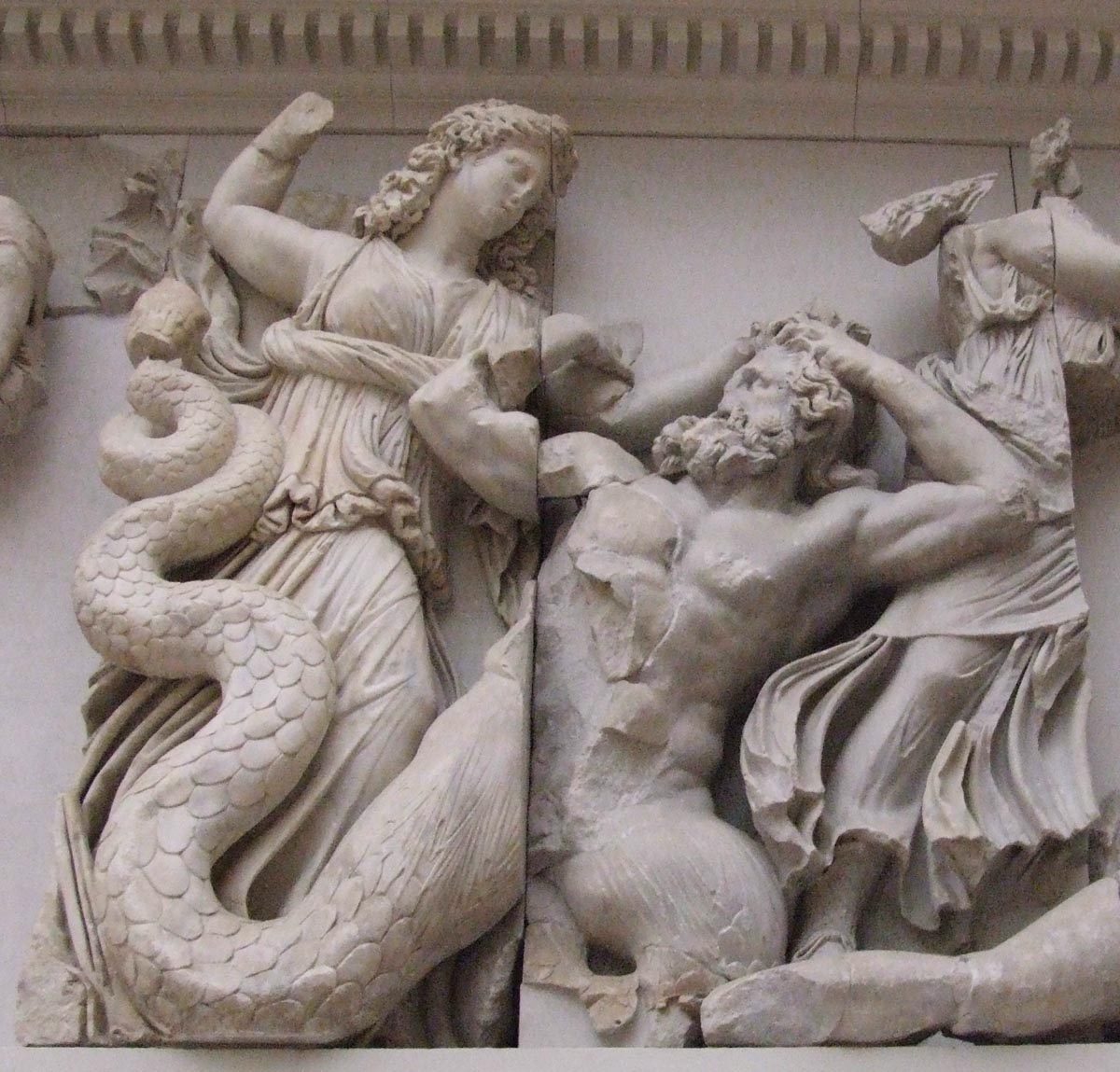
Many classical statues are known to us thanks to Roman copies. Rome in general was the successor of Greek culture, but copies often simply could not convey the beauty of the originals, conveying only the plot. The difference was felt not so much in the lack of skill of the imitators, but in the spirit of the era itself. So, greek statues It was made of a different marble - yellowish, filled with light and warm tones. This was achieved by rubbing the marble with wax.
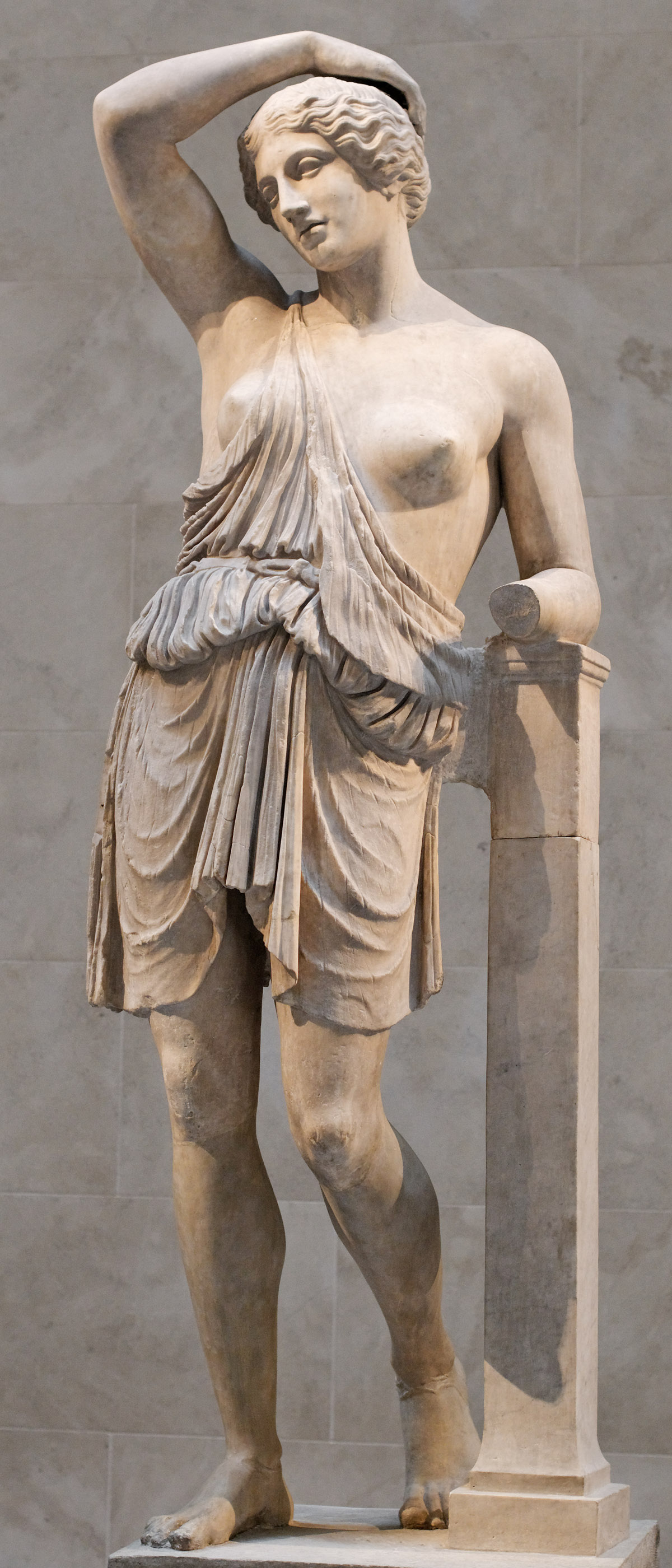
Favorite motives ancient Greek sculptors- accomplishments of mythical heroes, battles of the Olympic gods with the Titans, sports competitions. Due to the specifics of the sculpted greek sculptors learned to skillfully recreate the human body in motion, depicting complex poses.
The innovator here is considered to be the Attic sculptor Myron and his “Discobolus”. The athlete swings, preparing to launch the discus, he is tilted and tense, another moment - the throw will be completed and the athlete will relax his limbs. But Miron captured exactly this second, when the athlete froze in a position that seemed unstable but, at the same time, in balance.
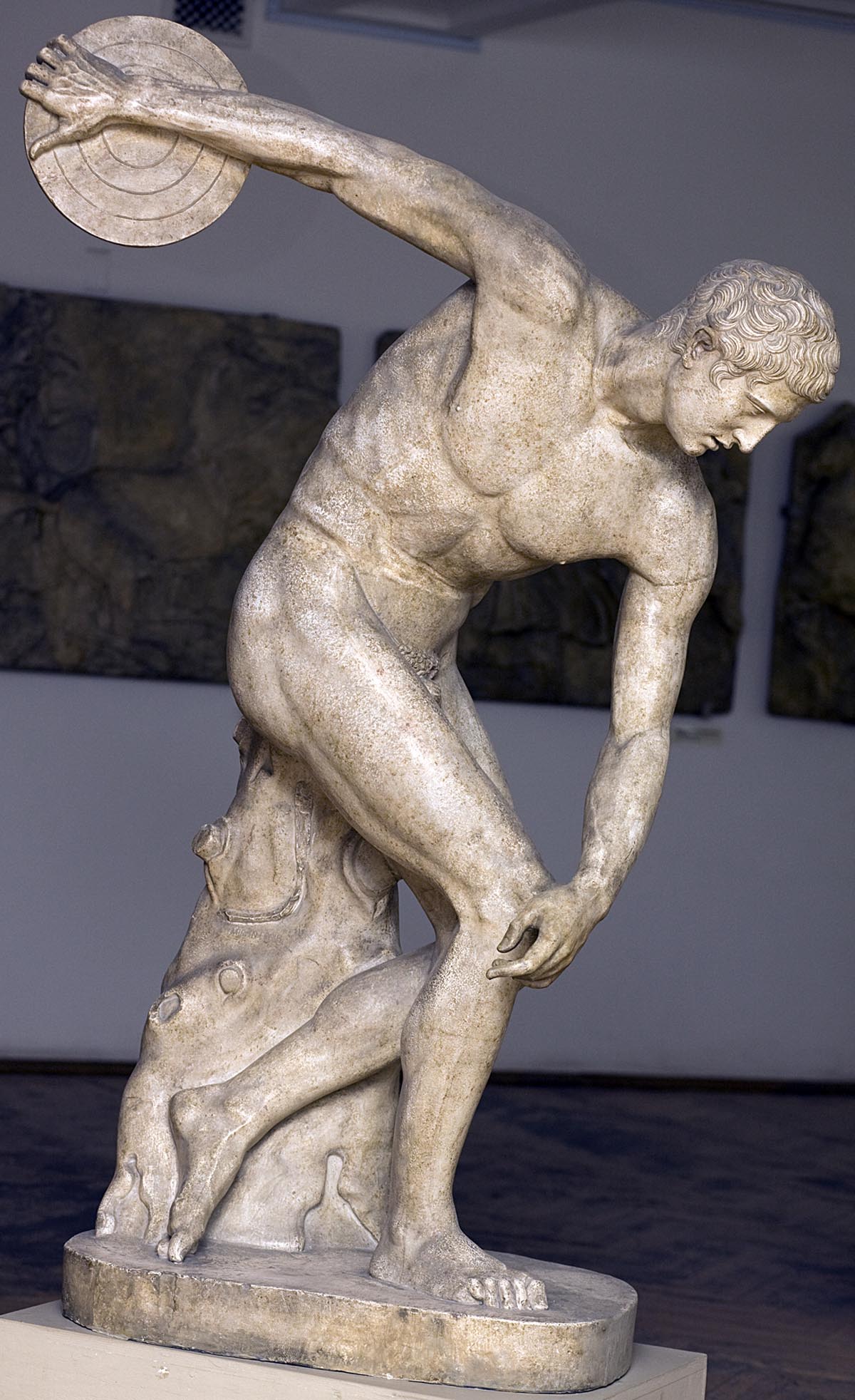
A relatively well-preserved Greek original by an unknown author, presumably Sotades, is a bronze statue of the Charioteer discovered at Delphi. Experts attribute it to the period of strict style (c. 470 BC). Look at this young man. He controls four horses, but is absolutely calm. He stands without shoes, the flutes of Doric columns appear in the folds of his tunic, and his hair is tied on his forehead with a silvered bandage. Look into his eyes - they are alive, full of energy. What is common to everyone outstanding sculptures, “The Charioteer,” when viewed from different angles, “reveals” its various facets to the contemplator. This bronze figure alone, its strong, cast plastic, allows you to feel what exactly the ancient Greeks understood by human dignity.

The Hellenes worshiped the beauty and wisdom of the structure of the living body. They understood body language as the language of the soul. As a result, Greek masters mastered the art of conveying “typical” psychology, expressing through generalized human types the richest range of emotional experiences. For the same reason, the art of portraiture in Ancient Greece was relatively poorly developed - the whole body expressed the mood and essence of the depicted hero.

In the period from the end of the 6th to the 3rd centuries. BC e., the creators sought to express spiritual power and pep, but over time the emphasis shifted to excessive pathos, drama and lyrical contemplation. The sculptors were attracted by the delights of childhood, the strength of maturity, old age with its wisdom and femininity - its charm, seduction and chastity. Scopas, Praxiteles and Lysippos are the greatest Greek sculptors of the late classical era. They had such an influence on the development of ancient art, which is comparable in importance to the sculptures of the Parthenon.
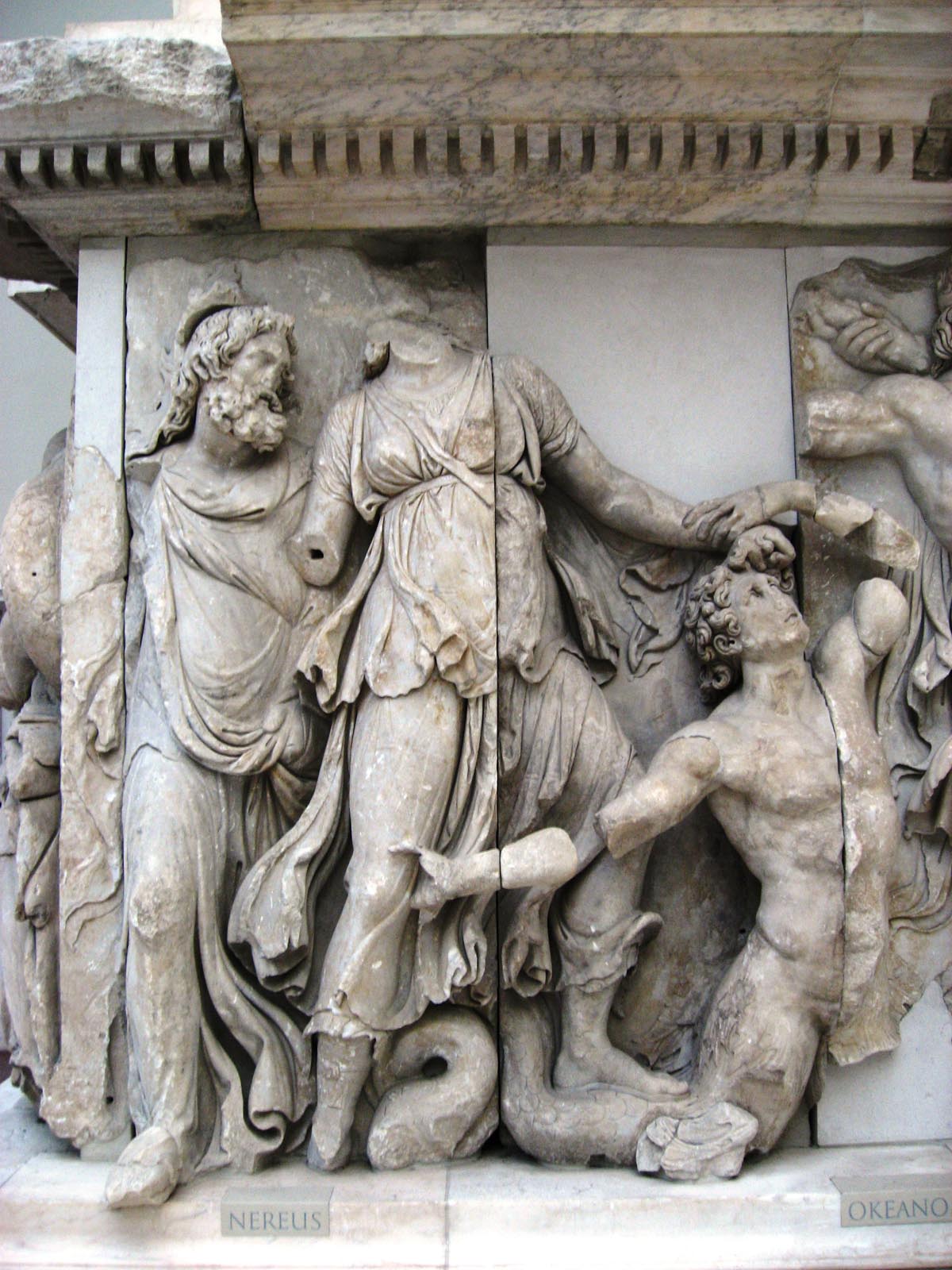
Peak classical sculpture Ancient Greece is generally believed to be the "Apollo Belvedere", by Leochares. This statue is synonymous with aesthetic perfection. “Apollo Belvedere” truly amazes with its plastic merits: the figure and gait of the ruler of the muses combines strength and grace, energy and lightness; walking on the ground, he at the same time soars above the ground. To achieve such an effect, the exceptional skill of the sculptor was required - the only problem is that the calculation for the effect is too obvious.
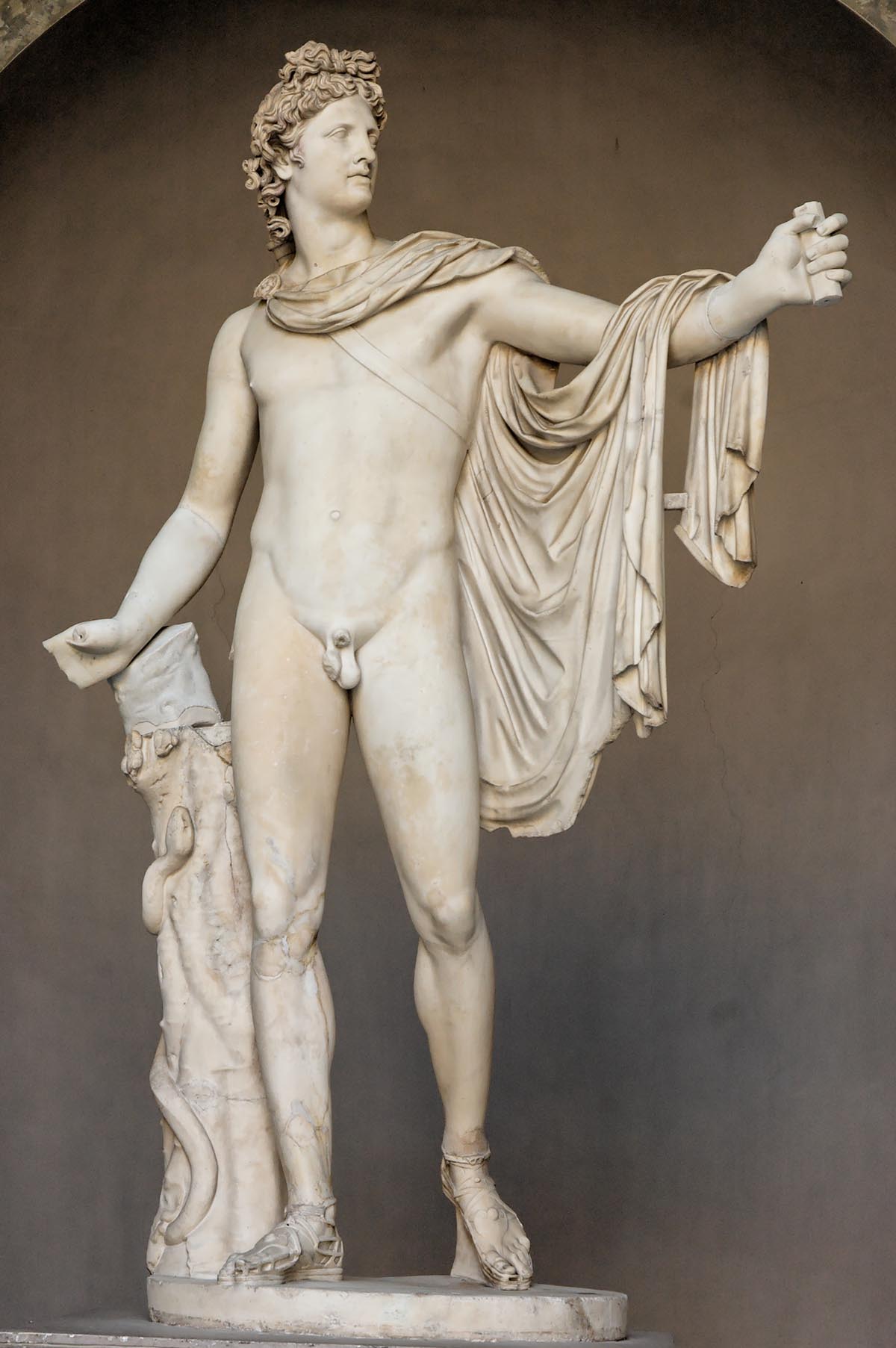
The ancient Greeks left behind a great cultural heritage, which can be considered a worthy reference point for the creators of today, once again emerging from a barbaric state.
Second half of the 5th century. BC. was a time of particularly significant flowering of the arts. This period is called the high classics.
The leading role in the flowering of the art of high classics belonged to Athens, the most developed polis politically, economically and culturally.
The art of Athens at this time served as a model for the art of other cities, especially those that were within the orbit of Athens' political influence. Many local and visiting artists worked in Athens - architects, painters, sculptors, and painters of red-figure vases.
Architecture of the third quarter of the 5th century. BC. acted as evidence of the victory of rational human will over nature. Not only in cities, but also among wildlife or on the deserted shores of the sea, clear and strict architectural structures dominated the surrounding space, introducing an ordered harmonious structure into it. Thus, on the steep Cape Sunium, 40 km from Athens, on the easternmost point of Attica, far out into the sea, around 430, the temple of the god of the seas Poseidon was built, as if the first city of Hellas proudly asserted its sea power.
Advanced architectural thought was expressed not only in the construction of individual buildings, outstanding for their artistic qualities, but also in the field of urban planning. For the first time in the era of Pericles, the correct (regular) planning of cities was widely carried out according to a single, well-thought-out plan. This is how, for example, the military and commercial harbor of Athens - Piraeus - was planned.
Unlike most older Greek cities, Piraeus had cobbled streets of equal width running strictly parallel to each other; They were crossed at right angles by transverse, shorter and narrower streets. Work on the planning of the city was (not earlier than 446 BC) carried out by the architect Hippodamus from Miletus, a native of Asia Minor Greece. The restoration of the cities of Ionia, destroyed by the Persians during the war, confronted architecture with the task of building according to a single plan. Here the first experiments in general planning in the history of architecture arose, on which Hippodamus relied in his activities. Basically, the layout was reduced, as it was in Piraeus, to the general layout of the blocks, and when planning the streets, the nature of the terrain, as well as the direction of the winds, were taken into account. The locations of the main public buildings were also determined in advance. The residential buildings of Piraeus were low buildings, facing the street with blank walls, and inside having a courtyard with a portico on its northern side in front of the entrance to the living quarters. These residential buildings were relatively uniform: in the 5th century polis inhabited by free citizens. BC. there was not the striking inequality that characterized later cities of Hellenistic and Roman times.
In Athens and under Pericles, the old, irregular layout was preserved. But the city was decorated with numerous new buildings: covered porticos (stands) that provided shade and protection from the rain, gymnasiums - schools where rich young men studied philosophy and literature, palaestre - premises for teaching boys gymnastics, etc. The walls of these public institutions were often covered with monumental painting. For example, the walls of the Poikile stoa, that is, the “Motley” stoa, were decorated with frescoes by the famous painter of the mid-5th century. BC. Polygnotus dedicated to the themes of the Trojan War and other mythical and historical episodes. All these buildings were built by the decision of the people to meet their needs. The citizens of Athens made extensive use of their public architecture.
But the most important building of the era of Pericles was the new ensemble of the Athenian Acropolis, which dominated the city and its environs. The Acropolis was destroyed during the Persian invasion; the remains of old buildings and broken statues were now used to level the surface of the Acropolis hill. During the third quarter of the 5th century. BC. new buildings were erected - the Parthenon, the Propylaea, the Temple of the Wingless Victory. The final building of the ensemble, the Erechtheion, was built later, during the Peloponnesian Wars.
On the hill of the Acropolis, therefore, the main sanctuaries of the Athenians were located and, first of all, the Parthenon - the temple of the Virgin Athena, the goddess of wisdom and patroness of Athens. The treasury of Athens was also located there; in the Propylaea building, which served as the entrance to the Acropolis, there was a library and an art gallery (pinakothek). On the slope of the Acropolis, people gathered for dramatic performances associated with the cult of the god of earthly fertility Dionysus. Steep and steep, with a flat top, the Acropolis hill formed a kind of natural pedestal for the buildings crowning it.
The sense of connection between architecture and the landscape, with the surrounding nature, is a characteristic feature of Greek art. It received its consistent development during the heyday of the classics. Greek architects were excellent at choosing sites for their buildings. Temples were built on rocky headlands, on hilltops, at the meeting point of two mountain ridges, on terraces of mountain slopes.
The temple arose where nature itself seemed to have prepared a place for it, and at the same time its calm, strict forms, harmonious proportions, light marble of columns, bright colors contrasted it with nature, asserting the superiority of the structure intelligently created by man over the surrounding world. Masterfully placing individual buildings of an architectural ensemble around the area, the Greek architects knew how to find a placement that combined them into an organically natural and at the same time deeply thought-out unity, free from strict symmetry. The latter was dictated by the entire artistic consciousness of the classical era.
This principle was revealed with particular clarity in the layout of the Acropolis ensemble.
The planning and construction of the Acropolis under Pericles was carried out according to a single, well-thought-out plan and in a relatively short time under the general leadership of the great sculptor of Greece, Phidias. With the exception of the Erechtheion, completed in 406 BC, all the main structures of the Acropolis were erected between 449 and 421. BC. The newly built Acropolis was supposed to not only embody the idea of the power and greatness of the Athenian maritime power and establish the advanced ideas of Greek slave-owning democracy at the highest stage of its development, but also express - for the first time in the history of Greece - the idea of pan-Hellenic unity. The entire structure of the ensemble of the Acropolis from the time of Pericles is permeated with noble beauty, calmly solemn grandeur, and a clear sense of proportion and harmony. In it one can see a clear implementation of the words of Pericles, full of pride in the culture of the “heart of Hellas - Athens”: “We love wisdom without effeminacy and beauty without whimsicality.”
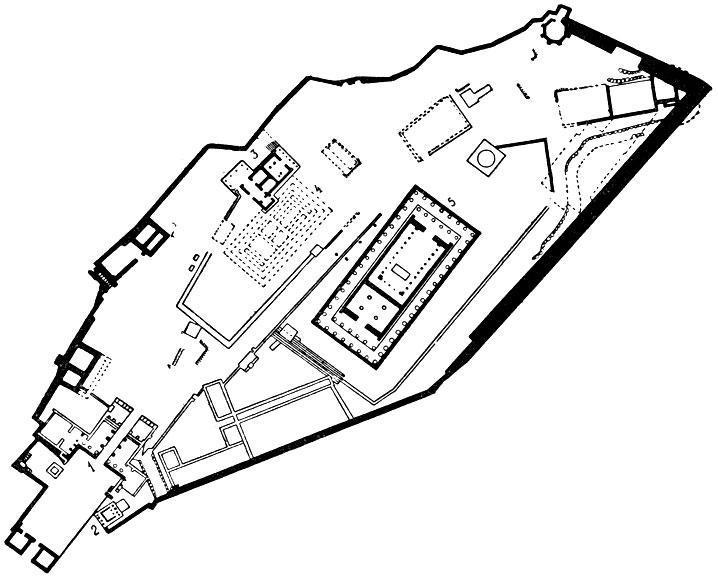
The full meaning of the layout of the Acropolis can only be understood by taking into account the movement of solemn processions on days of public celebrations.
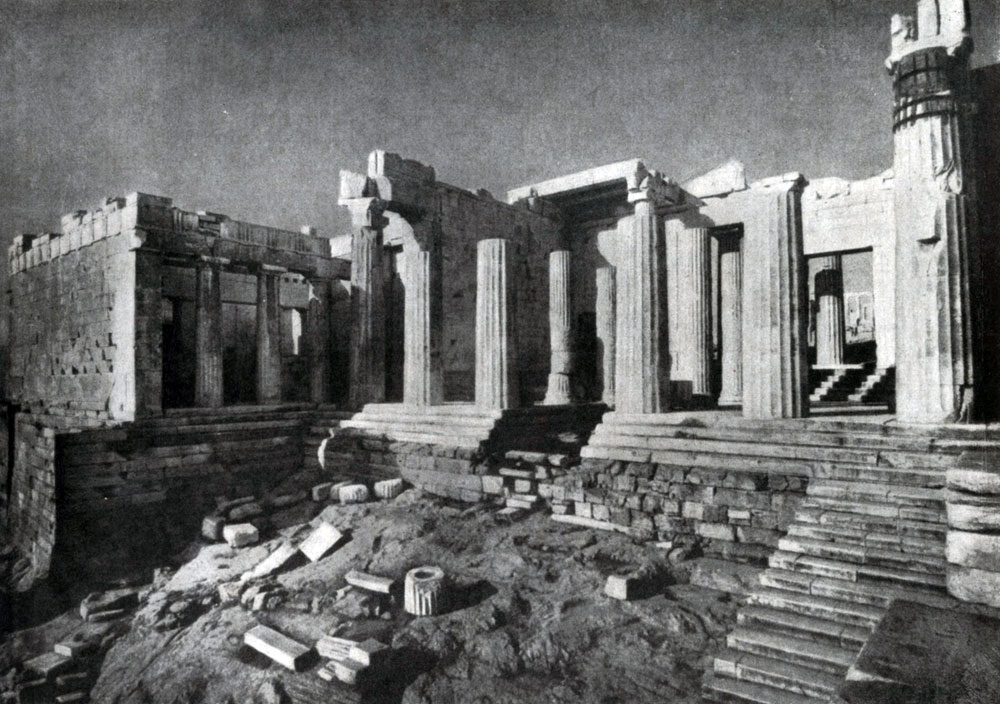
On the feast of the Great Panathenaia - the day when, on behalf of the entire city-state, Athenian girls brought the peplos they had woven as a gift to the goddess Athena - the procession entered the Acropolis from the west. The road led up to the ceremonial entrance to the Acropolis - the Propylaea, built by the architect Mnesicles in 437 - 432. BC. . The Doric colonnade of the Propylaea facing the city was framed by two unequal but mutually balanced wings of the building. One of them - the left one - was larger, but adjacent to the smaller one was the ledge of the rock of the Acropolis - Pyrgos, crowned with a small temple of Nike Apteros, that is, the Wingless Victory (“wingless” - so that it would never fly away from Athens).
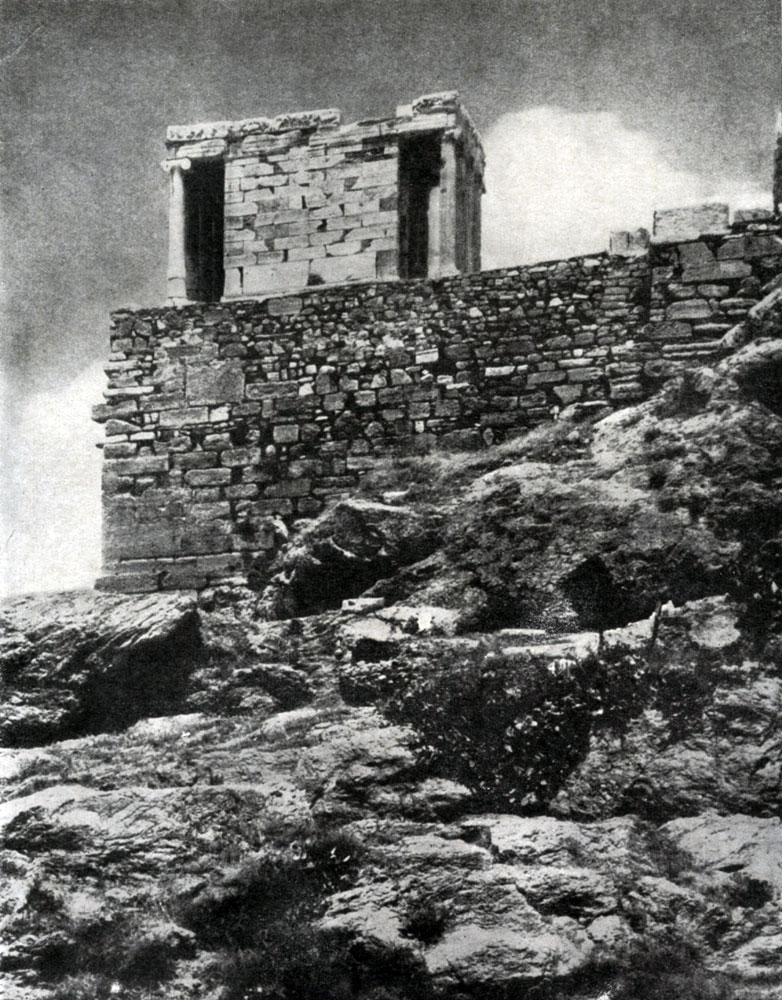
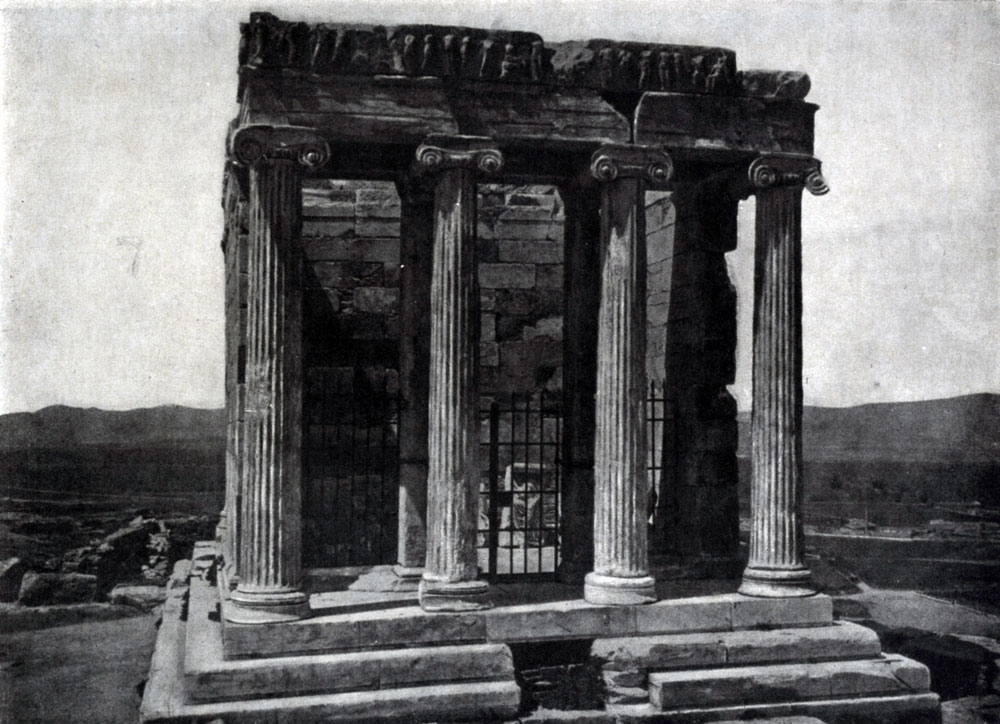
This small temple, crystal clear in form, was built by the architect Callicrates between 449 and 421. BC. Located below the other buildings of the Acropolis and as if separated from the general massif of the hill, it was the first to meet the procession at the entrance to the Acropolis. The temple stood out clearly against the sky; Four slender Ionic columns on each of the two short sides of the temple, built on the principle of amphiprostyle, gave the building a clear, calm grace.
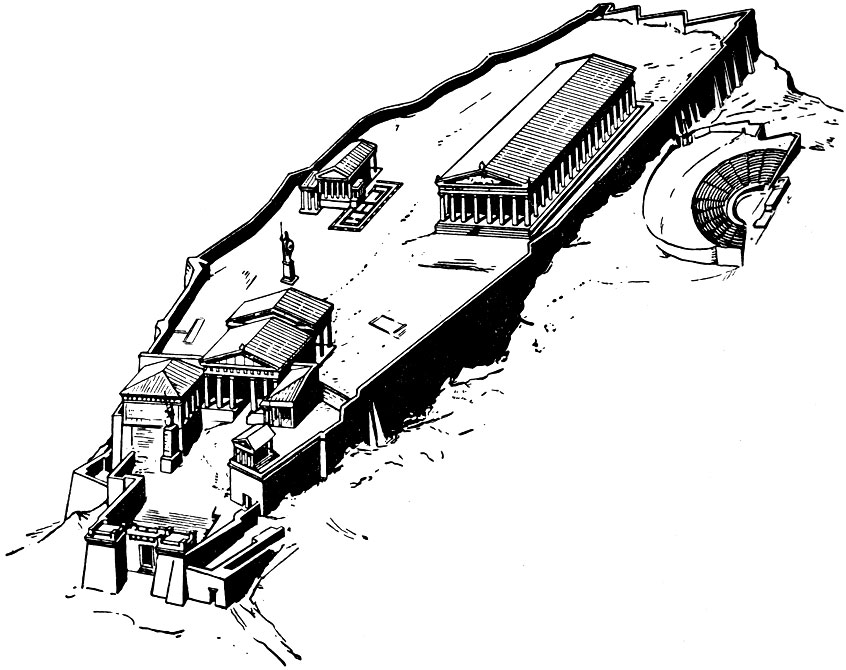
The layout of the Propylaea, as well as the Temple of Nike Apteros, skillfully used the unevenness of the Acropolis hill. The second, facing the Acropolis and also the Doric portico of the Propylaea, was located higher than the outer one, so that, passing through the Propylaea, the procession rose higher and higher until it entered a wide square. The interior of the Propylaea passage was decorated with Ionic columns. Thus, during the construction of the Acropolis, a combination of both orders was consistently carried out.
The principle of free planning and balance is generally characteristic of Greek art, including architectural ensembles of the classical period.
On the Acropolis Square, between the Propylaea, the Parthenon and the Erechtheion, there stood a colossal (7 m high) bronze statue of Athena Promachos (“Warrior”), created by Phidias even before the construction of the new Acropolis ensemble in the mid-5th century. BC.
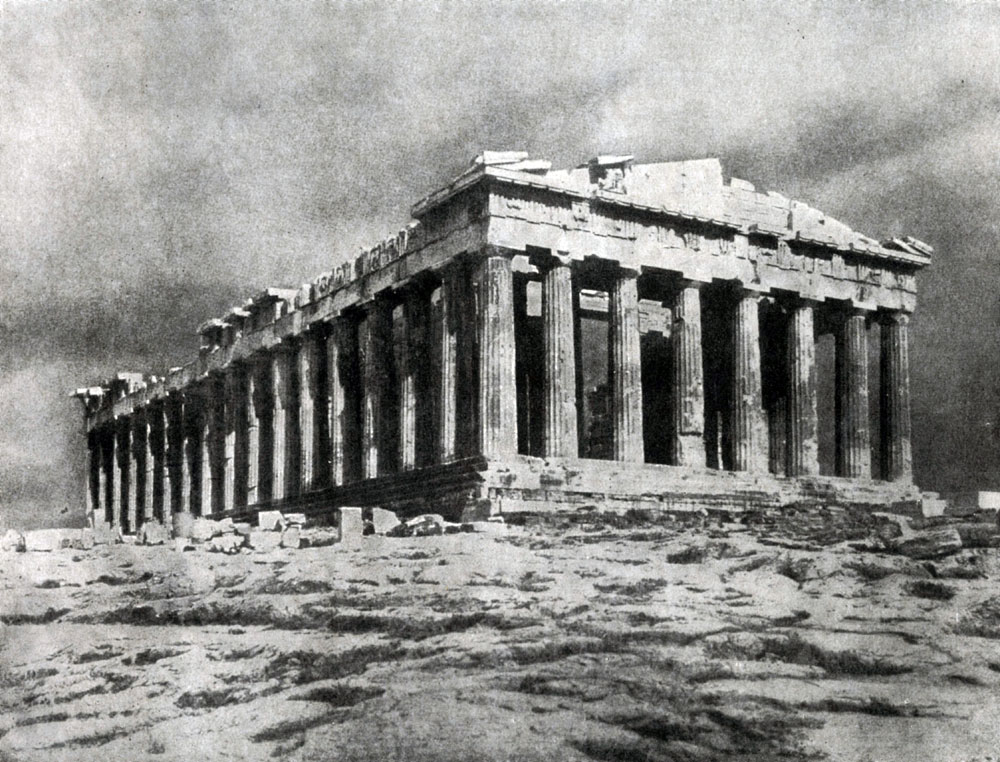
The Parthenon was not located directly opposite the entrance to the Acropolis, as the archaic temple of Hekatompedon once stood, but to the side, so that it was visible from the Propylaea from the corner. This made it possible to simultaneously view the western facade and the long (northern) side of the peripter. The festive procession moved along the northern colonnade of the Parthenon to its main, eastern facade. Large building The Parthenon was balanced by the elegant and relatively small building of the Erechtheion, standing on the other side of the square, which set off the monumental severity of the Parthenon with its free asymmetry.

The creators of the Parthenon were Ictinus and Callicrates, who began construction in 447 BC. and completed it in 438. Sculptural work on the Parthenon - Phidias and his assistants - continued until 432. The Parthenon has 8 columns on the short sides and 17 on the long sides: the overall dimensions of the building are 31 X 70 m, the height of the columns is 10.5 m.
The Parthenon became the most perfect creation of Greek classical architecture and one of the highest achievements in the history of architecture in general. This monumental, majestic building towers over the Acropolis, just as the Acropolis itself towers over the city and its surroundings. Although Athens had quite large funds, it was not at all gigantic size, and the harmonious perfection of proportions, the excellent proportionality of the parts, the correctly found scale of the building in relation to the Acropolis hill and in relation to man determined the impression of monumentality and high significance of the Parthenon. Glorification and exaltation, and not belittlement of man, formed the basis of the figurative impact of the Parthenon. Proportional to a person, easily grasped at first glance, the structure fully corresponded to the aesthetic ideals of the classics.
The Parthenon is built from squares of Pentelic marble, laid dry.
The Parthenon columns are placed more often than in early Doric temples, and the entablature is lighter. Therefore, it seems that the columns easily support the ceiling. Curvatures invisible to the eye, that is, a very weak convex curvature of the horizontal lines of the stylobate and entablature, as well as imperceptible inclinations of the columns inward and towards the center of the building, exclude any element of geometric dryness, giving the architectural appearance of the building amazing vitality and organicity. These slight deviations from geometric precision were the result of thoughtful calculation. The central part of the facade, topped with a pediment, visually presses on the columns and stylobate with greater force than the sides of the facade; the completely straight horizontal line of the base of the temple would seem to the viewer to be slightly bent. To compensate for this optical effect, the surface of the stylobate and other horizontal lines of the temple were made by the architects of classical times not exactly horizontally, but curved upward. The feeling of the barely perceptible convexity of the Parthenon stylobate enhances the impression of elastic tension that permeates its entire appearance. Other optical corrections introduced by the architect into the clear and orderly structure of the peripter also serve the same purpose.

The nobility of the material from which the Parthenon was built made it possible to use the usual coloring in Greek architecture only to emphasize the structural details of the building and to form a colored background against which the sculptures of the pediments and metopes stood out. Thus, red color was used for the horizontals of the entablature and the background of the metopes and pediments, and blue for the triglyphs and other verticals in the entablature; the festive solemnity of the structure was emphasized by narrow strips of discreetly introduced gilding.
Executed mainly in the Doric order, the Parthenon included individual elements of the Ionic order. This corresponded to the general desire of the classics and, in particular, the creators of the Acropolis ensemble to unite the Doric and Ionic traditions. This is the zophorus, ionic in nature, that is, the frieze running along the top of the outer wall of the naos behind the Doric colonnade of the peripterus, or the four columns of the Ionic order that decorated the inside of the “Parthenon” itself - the hall located behind the naos.
The Parthenon was decorated with sculpture of exceptional perfection. These statues and reliefs, which have partially reached us, were made under the direction and, probably, with the direct participation of Phidias, the greatest among the great masters of the high classics. Phidias also owned the 12-meter statue of Athena, which stood in the naos. In addition to the work performed for the Acropolis, which Phidias began as a mature master, he created a number of monumental statues for religious purposes, such as the giant statue of a seated Zeus that stood in the Temple of Zeus at Olympia, which amazed contemporaries with its expression of humanity. Unfortunately, none of the famous statues of Phidias has reached us. Only a few unreliable Roman copies have survived, or rather, it would be better to say - variants dating back to Phidias’ statues of Athena and to his other works (“Amazon”, “Apollo”).
For the Acropolis, Phidias created three statues of Athena. The earliest of them, apparently created under Cimon in the second quarter of the 5th century. BC. and commissioned with funds from the Marathon spoils, was the above-mentioned Athena Promachos, who stood on the Acropolis square. The second was the smaller Athena Lemnia (that is, Lemnos). The third, Athena Parthenos (that is, Athena the Virgin), was created in the 40s of the 5th century. BC, since in 438 it was already placed in the temple.
As far as can be judged from replicas and descriptions, cult statues Phidias embodied the image of human perfection that is quite real at its core. The greatness of the gods of Phidias was revealed in their high humanity, and not divinity.
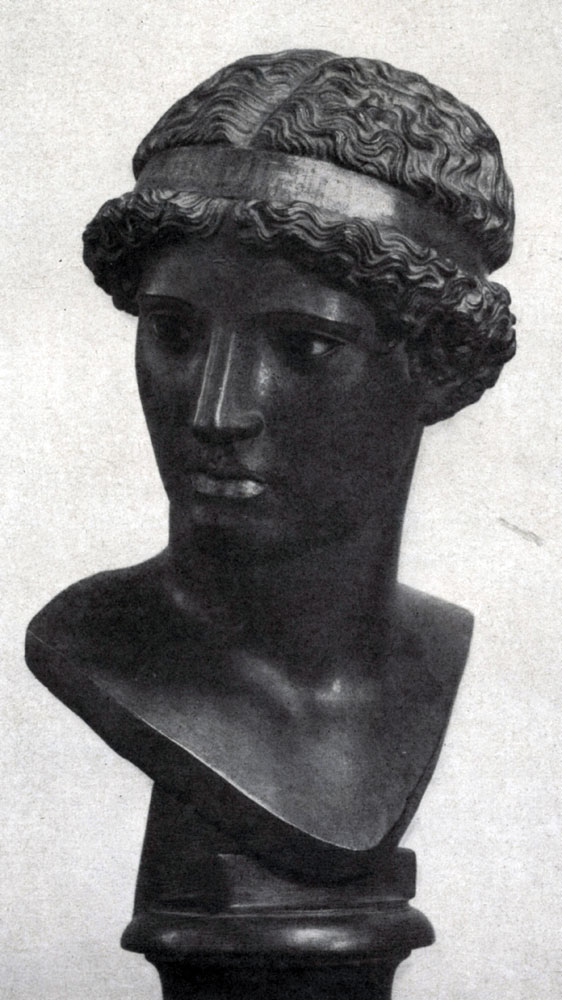
Thus, Athena Promachos (“Warrior”), depicted in full armor, calmly and imperiously looked around the city spread out at her feet and vigilantly guarded it from threatening dangers. The connection with the surrounding life and the specificity of the plot motif were obviously characteristic of this statue. The beautiful Roman copy of the head of Athena Lemnia, kept in the Museum of Bologna, gives an idea of what enormous life content the images of high classics could be imbued with, although some scholars have expressed doubts whether this is really a copy of the Phidias statue. The combination of sublime beauty with a very definite facial expression, conveying attention, energy and self-confidence full of tense alertness, gives the image a special vitality.
The torso of Athena Lemnia, which has come down to us in a Roman marble copy (Dresden), gives an idea of the perfection with which Phidias created a calmly and solemnly standing monumental statue. The clear and simple silhouette is beautiful, easy to read from a great distance; Internal tension and restrained energy of movement are expressively conveyed. This statue is an example of a perfect solution to the problems posed by the early classics, striving to create an image that combines monumental grandeur with concrete vitality.
The Athena Parthenos was somewhat different from the earlier Athens of Phidias. The cult character of the statue standing in the temple required greater solemnity of the image. Hence the inclusion of symbolic details in the image of Athena: a snake at Athena’s feet, a figure of Victory on her outstretched right hand, a magnificent helmet crowning her head, etc. This also determines the sublime impassivity of the image, if you believe the rather distant replicas of Roman times.
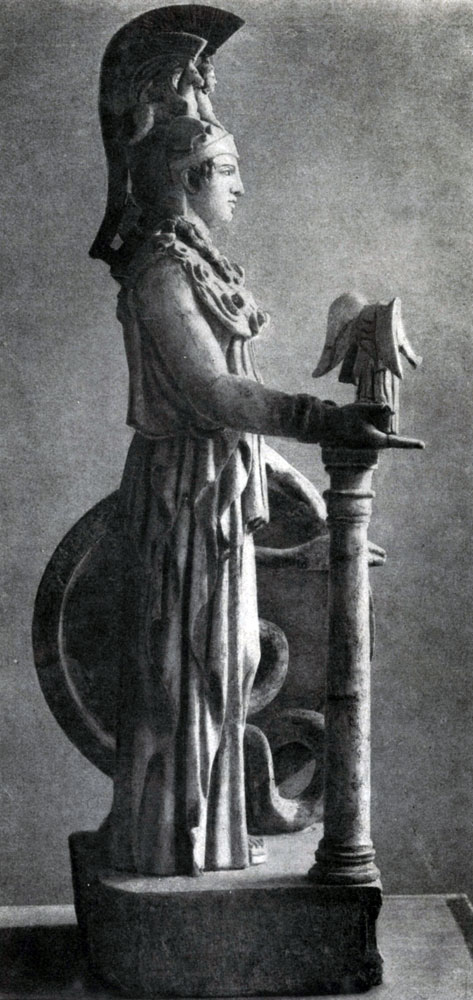
The round shield of Athena depicted the battle between the Greeks and the Amazons, full of violent movement and a direct sense of life. Among the characters, Phidias placed an image of Pericles marked by portrait resemblance and his own self-portrait, which was a manifestation of new quests that were not characteristic of the realism of the early and high classics and foreshadowed the approach of the next stage in the development of classical art. For this daring undertaking, Phidias was accused of atheism. “He was especially accused of the fact that, while depicting the battle with the Amazons on the shield, he minted his own image in the form of a bald old man lifting a stone with both hands, as well as a beautiful portrait of Pericles fighting with the Amazon. He very skillfully positioned the hand raising the spear in front of Pericles’ face, as if he wanted to hide the resemblance, but it is still visible on both sides” (Plutarch, biography of Pericles).
One of the notable features of the statues of Athena Parthenos and Olympian Zeus was the chrysoelephantine technique of execution, which, however, existed before Phidias. The wooden base of the statues was covered with thin sheets of gold (hair and clothing) and plates of ivory (face, hands, feet).
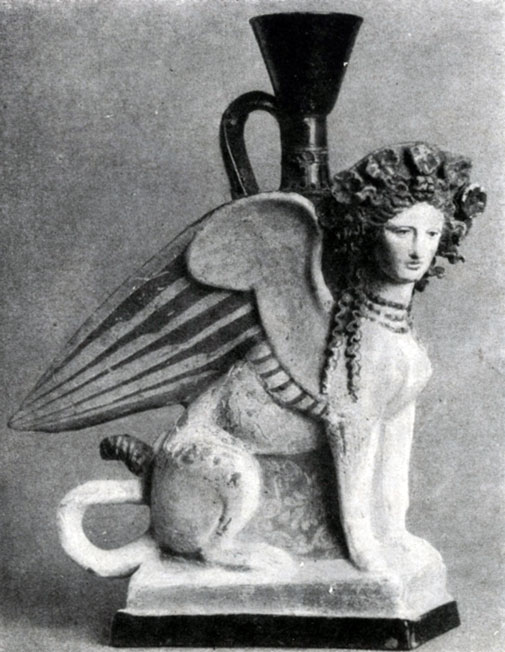
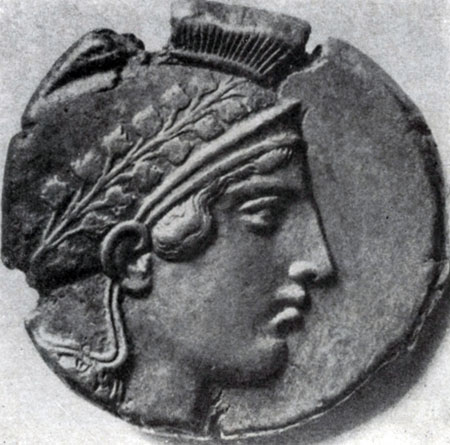
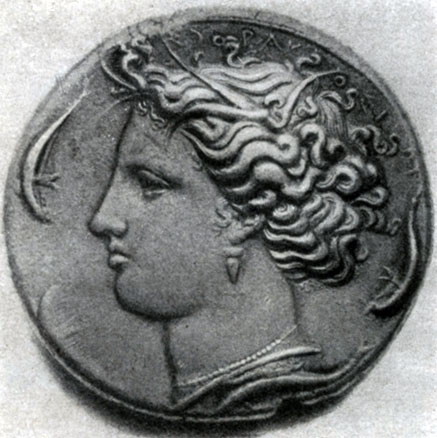
An idea of the impression that the chrysoelephantine technique could produce can be given by a small figured lekythos of Attic work from the end of the 5th century. BC, found in the Northern Black Sea region on the Taman Peninsula, the so-called “Taman Sphinx”, one of the pearls of the ancient collection of the State Hermitage in Leningrad. This vase is a fine example of Greek figured pottery from classical times, remarkable for its subtle sense of joyful color, combining grace with monumental clarity of image. The golden braids, tiara and necklace, white face and chest lightly tinted with pink are clearly inspired by examples of chrysoelephantine technique.
If we imagine that the statue of Athena, shining with gold, was in a relatively dark room compared to the brightly lit area of the Acropolis, that the stripes of gilding on the outer parts of the Parthenon seemed to prepare the viewer for the expected spectacle, that inside the naos was painted red and blue and a number of details was highlighted with gilding, then we have to admit that the golden radiance of the statue of Athena was in harmony with the general character of the colorful range of architectural decoration of the building.
The most complete picture of the work of Phidias and, in general, of the sculpture of the heyday of the classics can be given by the sculptural groups and reliefs that adorned the Parthenon, preserved in the originals, although badly damaged ( Significant destruction of the Parthenon sculptures was not caused by time. christian temple, then into the mosque, the Parthenon stood intact until the end of the 17th century. In 1687, during the bombardment of Athens by the Venetian fleet, a bomb hit the Parthenon, which the Turks turned into a gunpowder warehouse. The explosion caused significant destruction. What the bomb did not do was at the beginning of the 19th century. the sculptures were completed by the English envoy to Turkey, Lord Elgin. Taking advantage of permission to remove several slabs with inscriptions, he stole almost all the sculptures and at night, fearing popular outrage, took them to London. When the statues were removed from the already damaged western pediment, it collapsed and was broken.).
These sculptures, as mentioned above, were created by a group of the best sculptors, led by Phidias. It is very likely that Phidias was directly involved in the execution of the sculptures themselves. It can be argued that, in any case, the compositional solution, interpretation of the plots and, possibly, sketches of the figures belong to Phidias. To this day, the sculptural ensemble of the Parthenon is an unsurpassed artistic monument.
All 92 metopes of the temple were decorated with marble high reliefs. On the metopes of the western facade the battle of the Greeks with the Amazons was depicted, on the main, eastern facade - the battle of the gods with the giants, on the northern side of the temple - the fall of Troy, on the southern, better preserved - the struggle of the Lapiths with the centaurs. These themes had a deep meaning for the ancient Hellenes. The battle of gods and giants affirmed, in the image of the struggle of cosmic forces, the idea of the victory of the human principle over the primordial elemental forces of nature, personified by monstrous giants, the creation of earth and sky. Close in meaning to the first theme is the theme of the struggle of the Lapith Greeks with the centaurs. The Trojan stories had a more immediate historical significance. The historical myth about the struggle of the Greeks with the Trojans, personifying the Asia Minor East, was associated in the minds of the Hellenes with the recently won victory over the Persians.
A large multi-figure group placed in the tympanum of the eastern pediment was dedicated to the myth of the miraculous birth of the goddess of wisdom Athena from the head of Zeus. The Western group depicted the dispute between Athena and Poseidon for the possession of Attic land. According to the myth, the dispute was resolved by comparing the miracles that Poseidon and Athena were supposed to perform. Poseidon, striking a rock with his trident, brought out salty healing water from it. Athena created the olive tree - this basis for the agricultural well-being of Attica. The gods recognized Athena's miraculous gift as more useful to people, and dominion over Attica was transferred to Athena. Thus, the western pediment, which was the first to meet the solemn festive procession heading towards the Parthenon, reminded the Athenians of why Athena became the patroness of the country, and the main, eastern pediment, at which the procession ended, was dedicated to the theme of the miraculous birth of the goddess - the patroness of Athens and the solemn image of Olympus.
Along the wall of the naos behind the columns, as already mentioned, there was a zophorus depicting the festive procession of the Athenian people in the days of the Great Panathenaia, which directly by its very theme connected the clearly thought out ensemble of sculptures of the Parthenon with real life.
The sculptures of the Parthenon give a clear idea of the enormous path that was covered by Greek art in just 40-50 years, separating the time of the creation of the Acropolis complex from the sculptures of the Temple of Aegina.
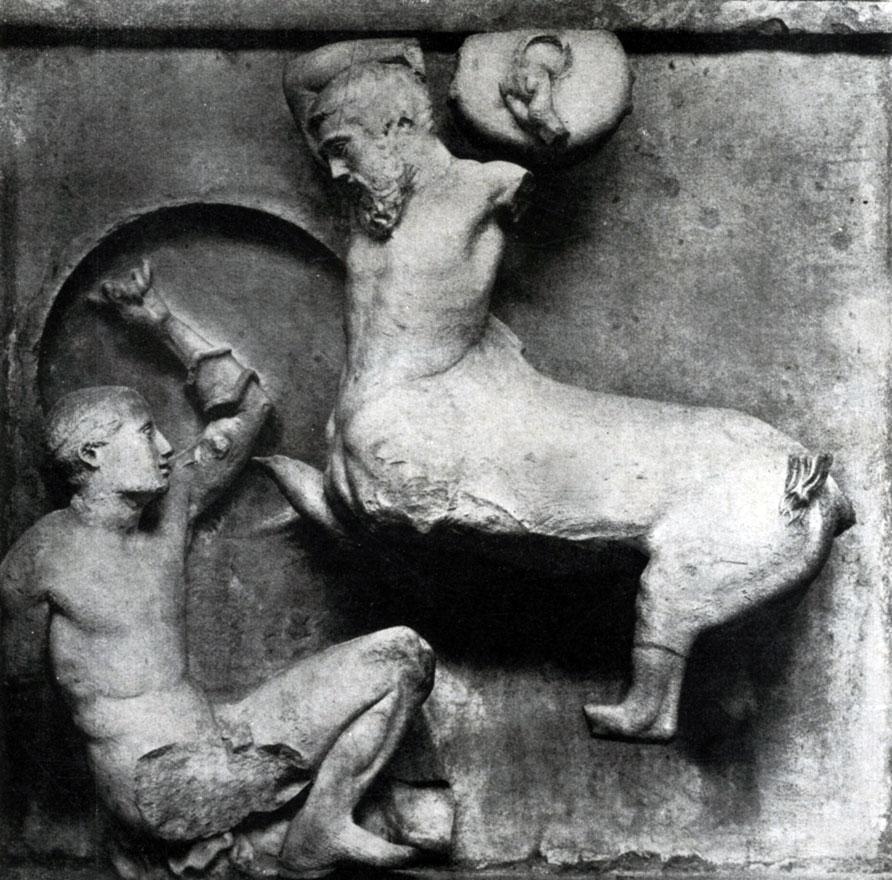
The surviving metopes, dedicated primarily to the struggle of the Lapiths with the centaurs, are two-figure compositions that successively unfold before the viewer the vicissitudes of this struggle. The variety of movements and the inexhaustible wealth of fighting motives in each new pair of combatants is amazing. Now the centaur, raising a heavy bowl over his head, attacks the lapith who has fallen and is covering himself with a shield, now the lapith and the centaur are intertwined in a fierce fight, clutching each other’s throats, then, with his arms outstretched, the victorious centaur prances over the lifeless body of the fallen Greek, now a slender young man, grabbing the centaur’s hair with his left hand, stops his rapid run, and with his right raises his sword for a fatal blow.
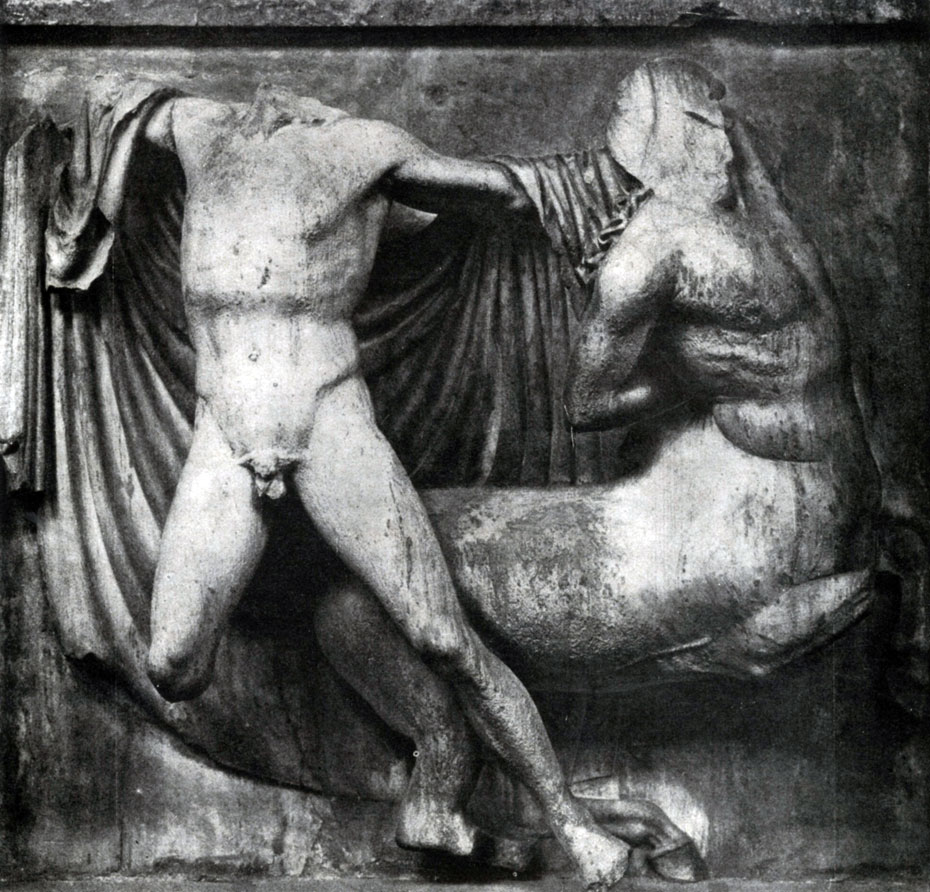
These metopes were clearly made by different masters. Some of them still have that sharp angularity of movement and emphasized rendering of individual details, which was, for example, in the western pediment of the Temple of Zeus at Olympia, dedicated to the same subject. In others, and the very best, one can see all the mastery of high classics in the natural and free reproduction of any real action and that deep sense of proportion that invariably preserves the harmonious beauty of the image of a perfect person. The movements of the Lapiths and Centaurs in these metopes are naturally free, they are determined only by the nature of the struggle that they are waging - there are no echoes of too obvious and strict subordination to the architectural form, which was also in the metopes of the Temple of Zeus at Olympia. Thus, in the excellent relief of the Parthenon, where the half-turned lapith, grasping the centaur’s hair with an imperious hand, stops his rapid run and bends his body, just as one bends a tight bow, the composition is subordinated to the logic of the movement of the figures and the scene as a whole and at the same time naturally corresponds to the limits space allocated by architecture.
This principle of a seemingly involuntary, freely emerging harmony of architecture with sculpture, which fully realizes its imaginative tasks and does not destroy the architectural whole, is one of the most important features of the monumental sculpture of high classics.
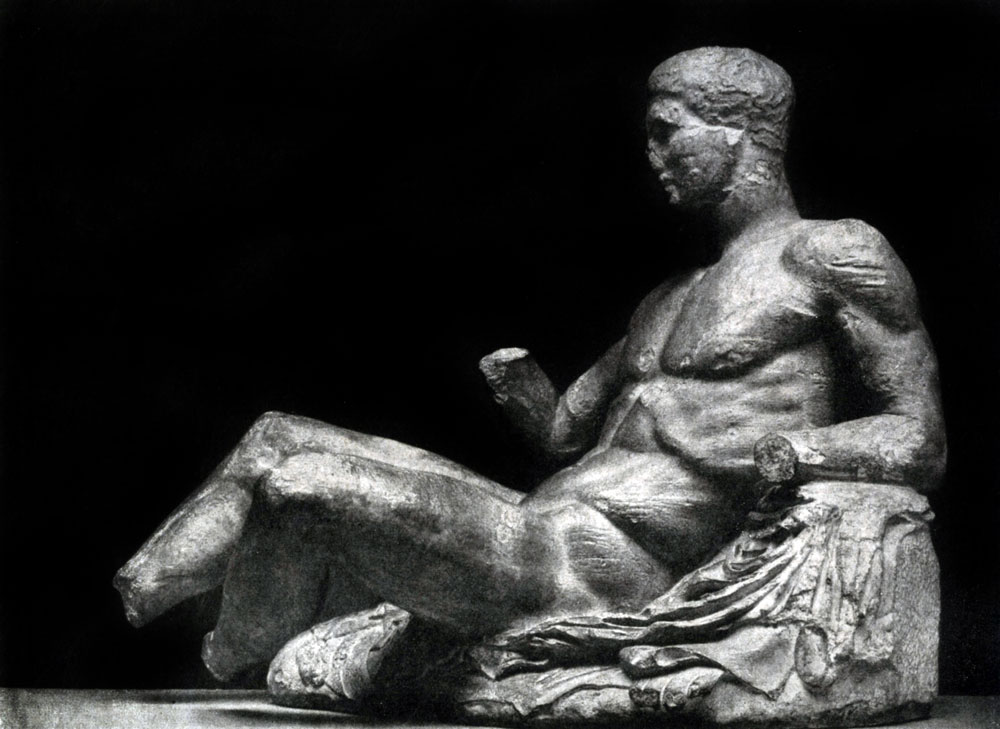
The compositions of both pediments are built on the same principle. When considering any of the figures of the pediments separately, it is difficult to assume that they are included in a composition strictly defined by the architectural structure. Thus, the pose of the reclining youth Cephalus from the eastern pediment is completely determined by the very motive of the figure’s movement, and at the same time it easily and clearly “fits” into the acute corner of the pediment in which this statue was located. Even on the western pediment of the Temple of Zeus at Olympia, the movements of the figures, for all their realistic truthfulness, were generally strictly deployed along the plane of the pediment. In such statues of the Parthenon as Cephalus (according to another interpretation - Theseus), complete freedom and naturalness of movement was achieved.
The composition of the eastern pediment and, above all, its unpreserved central part can be judged by the relief on the so-called Madrid puteal, where, however, the principle of the triangular arrangement of figures is violated. Phidias refused to highlight the axis of symmetry of the composition with a vertically standing central figure. The direct connection that this solution provided to the composition of the pediment with the rhythm of the colonnade was replaced by a much more complex relationship. The figures, free in their movements and full of life, created a group naturally placed within the triangle of the pediment and forming a clearly complete and self-contained artistic whole. In the center of the pediment, a half-naked Zeus was depicted sitting on a throne, and to the right of him, Athena, half turned towards him and quickly moving towards the right edge of the pediment, wearing a long chiton and weapons. Between him and at the top of the triangle was Nike (Victory) floating in the air, crowning Athena. Behind Zeus, to the left, Prometheus (or Hephaestus) was depicted, staggering back with an ax in his hand; to the right of Athena is the seated figure of Demeter, who was probably present here in her role as obstetrician. Thus, the balance of the composition was achieved here by a complex cross-correspondence of calmly sitting and rapidly moving figures. Further, on both sides of the central group, were the other gods of Olympus. Of all these figures, only the heavily damaged one on the far left has survived - Iris, the messenger of the gods. She is full of violent movement: the folds of her long clothes flutter in the wind, the play of light and shadow further enhances the dynamics of this statue. On the left, in the very corner of the pediment, Helios was placed - the sun god, rising from the waters of the Ocean on a quadriga; on the right is the goddess of the night Nyx (or Selene) descending downwards, just like Helios, cut off by the lower line of the phraton, with her horse. These figures, denoting the change for and night, thereby showed that the birth of Athena was significant for the entire universe from the east to the extreme west.
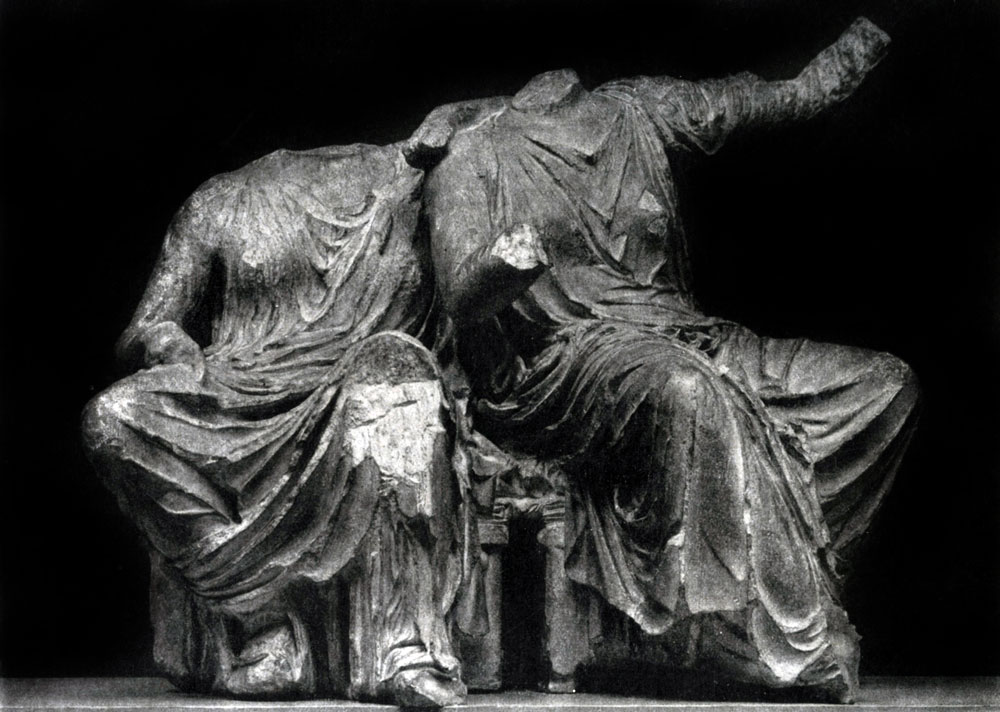
The reclining figure of a young man - Theseus or, perhaps, the awakening Cephalus, the mythical hunter who rises at dawn to hunt - meets Helios. Next to him were two seated female figures, usually considered Oras. Looking after the passing night (judging by the sketch of the pediment made in the 17th century) was one of the three beautiful girls, daughters of the night - the goddesses of fate Moira. These three female figures dressed in long clothes, forming a group at the right end of the pediment and which have come down to us, although without heads, but in a relatively better condition, belong, like the figure of Kephis from the western pediment, to the number greatest treasures Greek art.
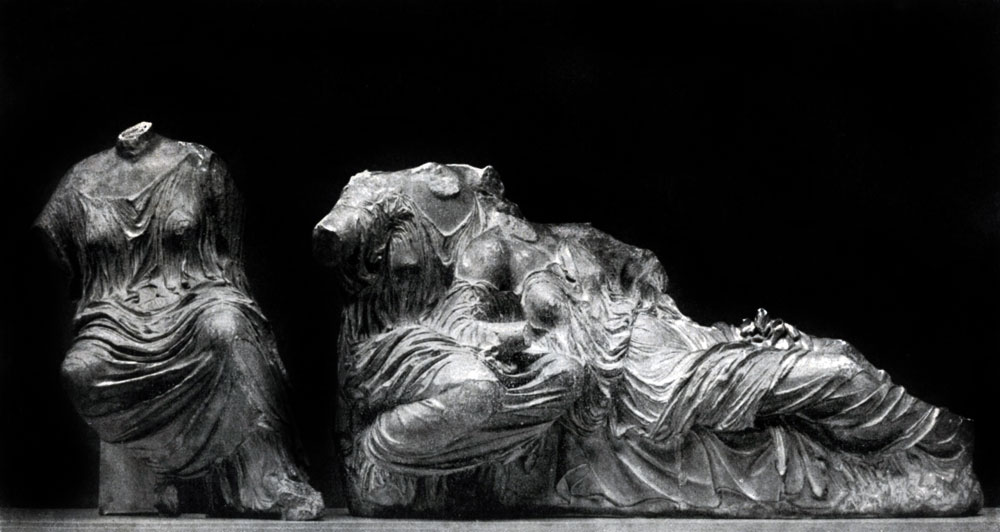
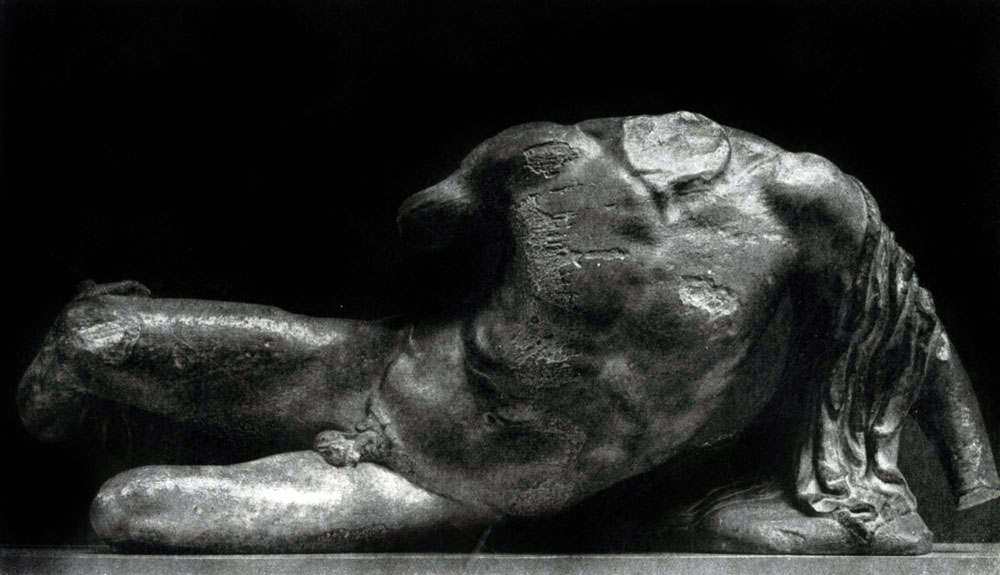
Of the surviving statues of the heavily destroyed western pediment, the most perfect are Cephisus, the smooth, flowing lines of whose body, indeed, seem to personify the river of Attica, the group of Cecrops, the legendary founder of the Athenian state, with his young daughter Pandrosa and the figure of Iris.
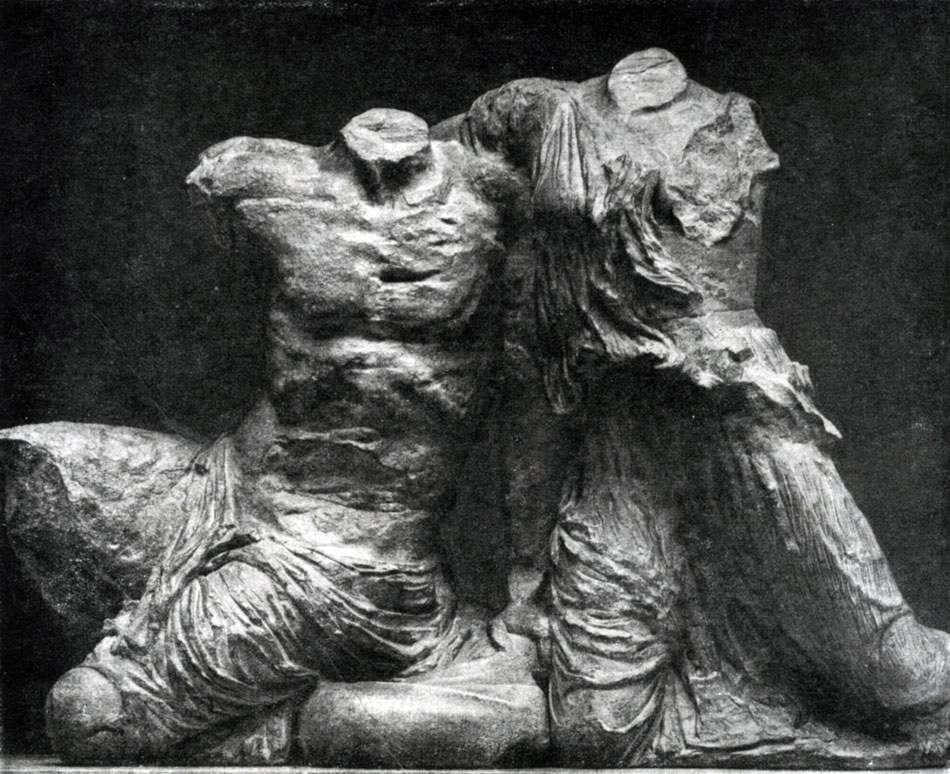
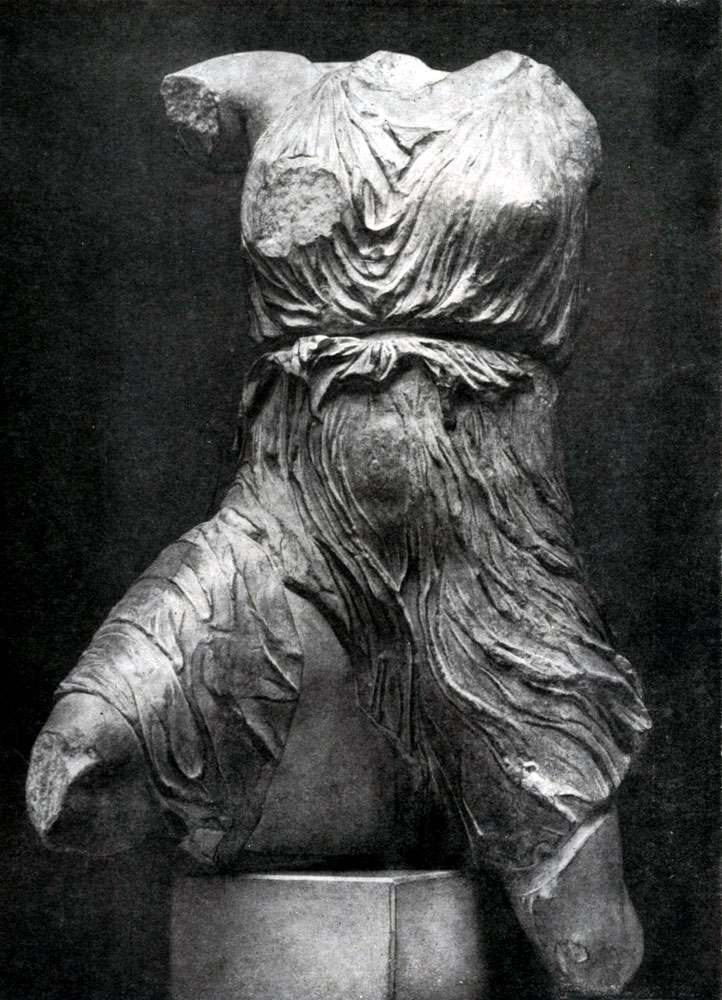
The beauty and majesty of the Parthenon pediment sculptures was achieved by selecting those subtly felt natural movements that, with their free expediency, most fully convey the plastic beauty and ethical perfection of man.
The frieze (zophorus) of the Parthenon gives a clear idea of the features of the construction of the classical relief. All the plans into which the relief is divided run parallel to each other, forming, as it were, a series of layers closed between two planes. The preservation of the plane of the wall is facilitated by a single movement of numerous figures directed strictly parallel to the plane of the wall. The clear change of plans and clear rhythmic structure of the frieze give the impression of extraordinary integrity of the image.
The creators of the zophora faced a difficult compositional task. It was necessary to surround the walls for about two hundred meters with a relief depicting one event - a popular procession - avoiding monotony and diversity, and to convey on the wall plane in low relief all the richness and diversity of the parade procession and its solemn harmony. The Zofor masters coped with their task brilliantly. Not a single motif of movement on the frieze is ever exactly repeated, and although the frieze is filled with many different figures of people walking, riding on horses or chariots, carrying baskets with gifts or leading sacrificial animals, the entire frieze as a whole is characterized by rhythmic and plastic unity.
The frieze begins with scenes of young horsemen preparing for the procession. The calm movements of young men tying straps on sandals or cleaning horses are offset from time to time by the sudden movement of a rearing horse or some swift gesture of a young man. Further, the motive of movement develops more and more quickly. The preparations are over, the procession itself begins. The movement either speeds up or slows down, the figures come closer, almost merging with each other, or the space between them expands. The undulating rhythm of movement permeates the entire frieze. Particularly remarkable is the line of galloping horsemen, in which the movement, powerful in its unity, consists of an infinite variety of similar, but not repeating movements of individual figures, different in their appearance. No less beautiful is the strict procession of Athenian girls, whose long clothes form measured folds, reminiscent of the flutes of the columns of the Parthenon. The rhythm of the girls’ movement is especially emphasized by the male figures (celebrators of the festival) turned towards them. Above the entrance, on the eastern facade, there are gods looking at the procession. People and gods are depicted as equally beautiful. The spirit of citizenship made it possible for the Athenians to proudly assert the aesthetic equality of the human image with the images of the deities of Olympus.
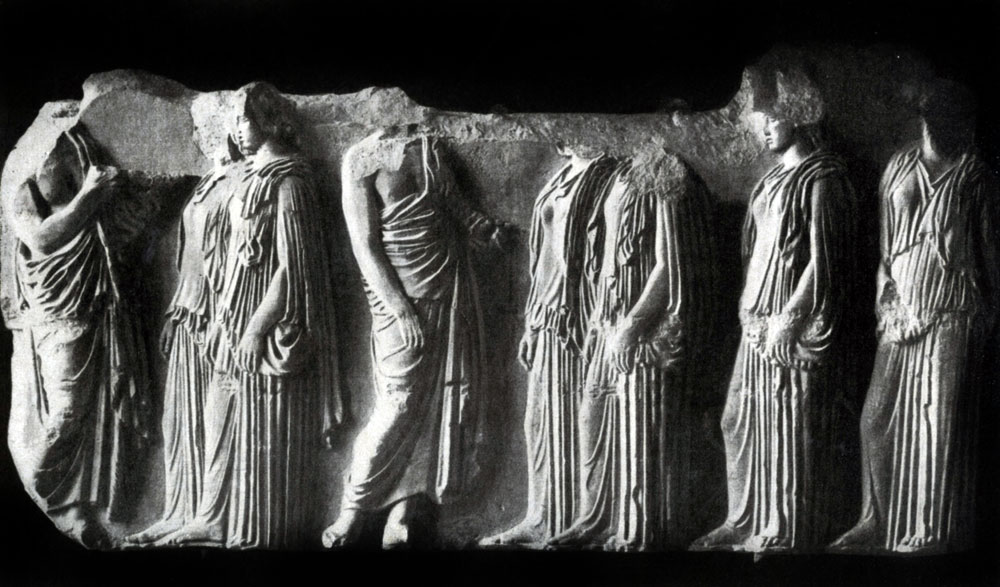
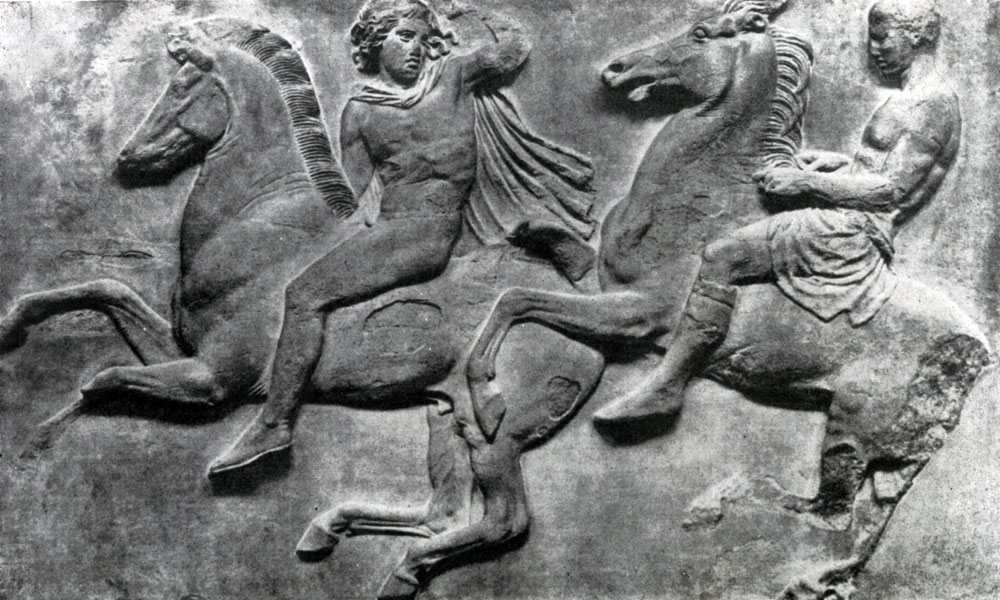
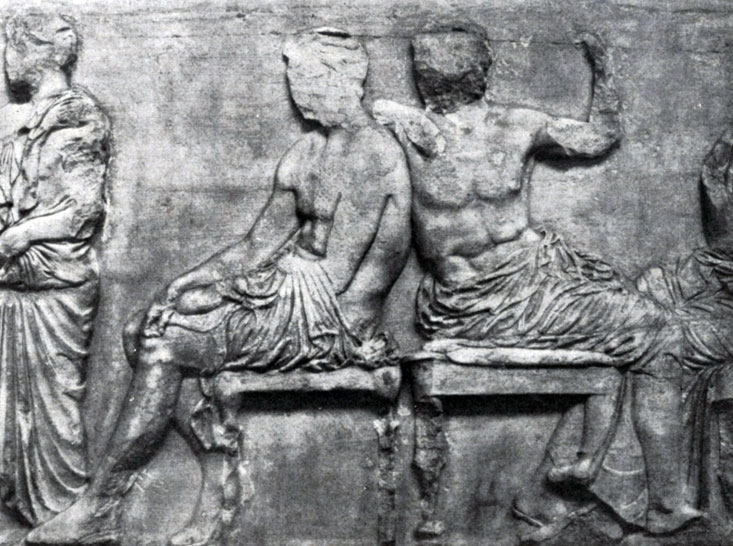
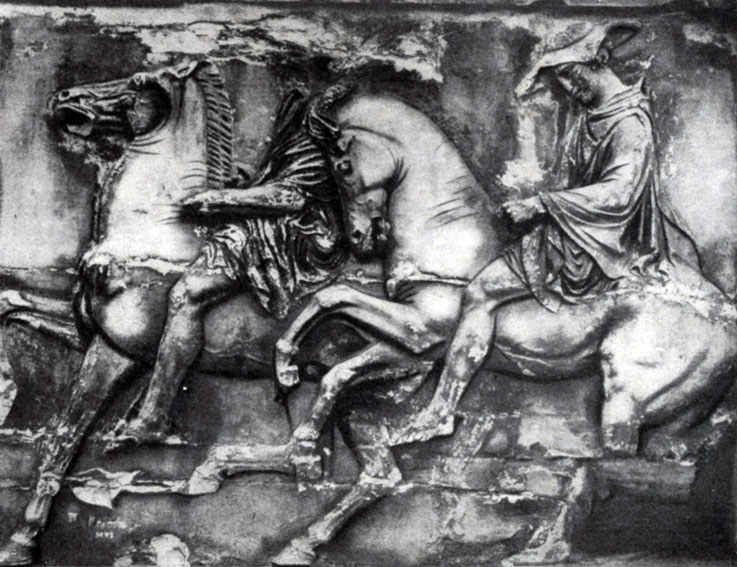
The direction represented in the art of sculpture of the second half of the 5th century. BC. Phidias and the entire Attic school headed by him occupied a leading place in the art of high classics. It most fully and consistently expressed the advanced artistic ideas of the era.
Phidias and the Attic school created an art that synthesized everything progressive that was carried in the works of the Ionic, Doric and Attic masters of the early classics up to and including Myron and Paeonius.
However, it does not follow from this that artistic life was concentrated only in Athens by the beginning of the second half of the century. Thus, information about the works of the masters of Asia Minor Greece was preserved, the art of the Greek cities of Sicily continued to flourish and southern Italy. The sculpture of the Peloponnese was of greatest importance, in particular the old center of development of Dorian sculpture - Argos.
It was from Argos that came Phidias Polykleitos, a contemporary, one of the great masters of Greek classics, who worked in the middle and third quarter of the 5th century. BC.
The art of Polykleitos is associated with the traditions of the Argive-Sicyon school with its primary interest in depicting a calmly standing figure. Conveying complex movement and active action or creating group compositions were not among Polykleitos's interests. Unlike Phidias, Polykleitos was to a certain extent associated with the more conservative circles of the slave-owning policy, which were much stronger in Argos than in Athens. The images of the statues of Polykleitos echo the ancient ideal of the hoplite (heavily armed warrior), stern and courageous. In his statue “Doriphoros” (“Spearman”), made around the middle of the 5th century. BC, Polykleitos created the image of a young warrior who embodied the ideal of a valiant citizen.
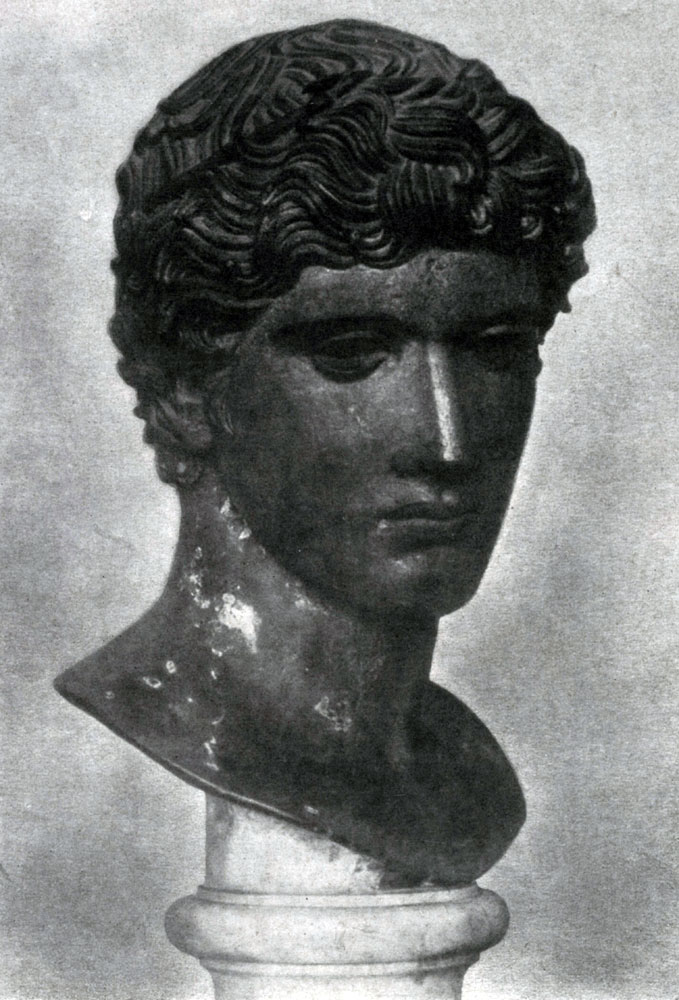
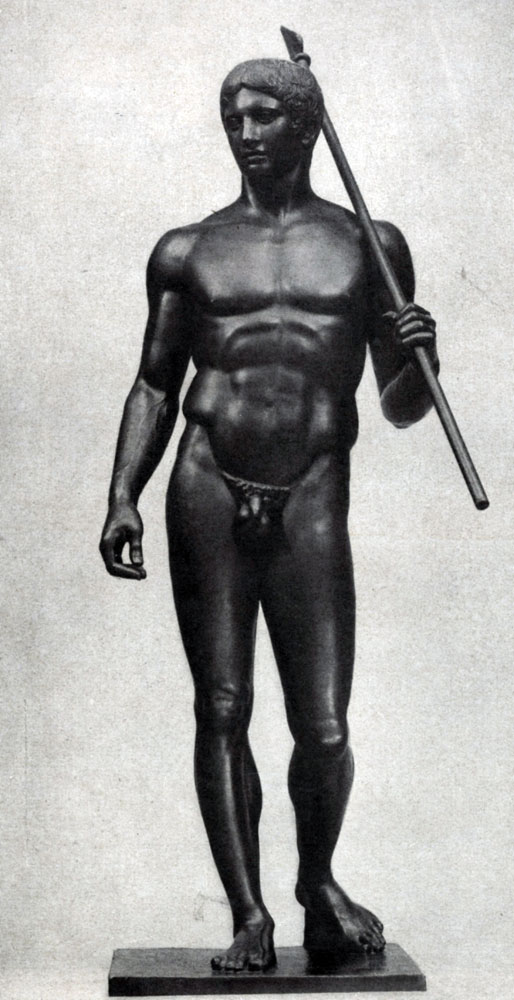
This bronze statue, like all the works of Polykleitos, has not reached us in the original; it is known only from marble Roman copies. The statue depicts a strongly built young man with strongly developed and sharply emphasized muscles, carrying a spear on his left shoulder. The entire weight of his body rests on his right leg, while his left leg is set back, touching the ground only with his toes. The balance of the figure is achieved by the fact that the raised right hip corresponds to the lowered right shoulder and, conversely, to the lowered left hip - a raised left shoulder. This system of constructing the human figure (the so-called “chiasmus”) gives the statue a measured, rhythmic structure.
The calmness of the figure of Doryphoros is combined with internal tension, giving his seemingly impassive image great heroic strength. The precisely calculated and thoughtful architectonics of constructing the human figure is expressed here in the juxtaposition of the elastic vertical lines of the legs and hips and the heavy horizontal lines of the shoulders and muscles of the chest and abdomen; this creates a balance imbued with opposing forces, similar to the balance that the ratio of column and entablature gives in the Doric order. This system of artistic means, developed by Polykleitos, was an important step forward in the realistic depiction of the human body in sculpture. The patterns he found in the sculptural depiction of a person actually corresponded to the spirit of heroic masculinity, which was characteristic of the image of a person in the classical period of Greece.
In an effort to theoretically substantiate the generalized typical image of a perfect person born in real life, Polykleitos came to the composition of the “Canon”. This is what he called his theoretical treatise and the statue made according to the rules of the theory; they developed a system perfect proportions and the laws of symmetry, according to which the image of a person should be constructed. This normative tendency was fraught with the danger of the emergence of abstract schemes. It can be assumed that the Roman copies strengthened those features of abstraction that were characteristic of the works of Polykleitos. Among the authentic Greek bronze figurines of the 5th century that have survived to this day. BC. some are undoubtedly closer in spirit to the art of Polykleitos. This is the figurine of a naked youth kept in the Louvre. The somewhat heavy proportions, as well as the motif of restrained movement, are reminiscent of the work of Polykleitos. The Greek original makes it possible to appreciate the features of the artistic language of Polykleitos, lost in the transcription of Roman copyists. The Louvre young athlete, with all the analytical accuracy and precision of construction, is distinguished by the naturalness of the gesture and the vital convincingness of the image.
At the end of his life, Polykleitos moved away from strict adherence to his “Canon”, becoming closer to the masters of Attica. His “Diadumen” - a young man crowning himself with a victorious bandage - a statue created around 420 BC, clearly differs from “Doriphoros” in its more graceful and slender proportions, easy movement and greater spirituality of the image.
A Roman copy of the “Wounded Amazon” by Polykleitos and a Roman statue of the “Amazon Mattei”, dating back to the original by Phidias, have survived to this day. They provide, to a certain extent, the opportunity to visually compare the features of Fidiev's and Polykleitov's contributions to the art of classics.
The Amazon of Phidias is depicted at the moment when she, looking back at the approaching enemy, leans on a spear, ready to jump on a horse. Her beautiful proportions better convey the structure of the girl’s strong body than the almost masculine proportions of the Amazon Polykleitos, built according to the “Canon”. The desire for active action, the relaxed and expressive beauty of movement are characteristic of the art of Phidias, an artist more multifaceted than Polykleitos, who more fully combines into a single whole the perfect beauty of the image with its concrete vitality.
Polykleitos depicted a wounded Amazon. Her strong body weakened, she leaned her left hand on the support, her right hand was thrown behind her head. But Polykleitos limited himself to this; in the face of the statue there is no expression of pain and suffering, and there is no realistic gesture conveying the movement of a person suffering from a wound. These elements of abstraction make it possible to convey only the most general state of a person. But the ideal of a person’s courageous restraint, the dissolution of his experiences in the general spirit of mastering oneself - these characteristic features of the art of Polykleitos carried within them high concepts of the dignity of a perfect person - a hero.
If Polykleitos was able to give, next to the high and beautiful art of Phidias and his comrades in decorating the Acropolis, his own important and significant version of the art of high classics, then the fate of his creative legacy was different. At the end of the 5th century. BC, during the Peloponnesian Wars, the successors of Polykleitos entered into a direct struggle with the realistic tradition of the Phidias school. Such Peloponnesian sculptors of the late 5th century. BC, like Callimachus, sought only abstract normative perfection, far from any living sense of reality.
But also in the Attic school, among the students and followers of Phidias, realistic quests were received in the last quarter of the 5th century. BC. some new features.
![]()
Among the direct students of Phidias, who remained completely faithful to their teacher, Cresilaus, the author of the heroic portrait of Pericles, stands out. This portrait deeply and powerfully expresses the calm greatness of spirit and the reserved dignity of a wise statesman. Beautiful human images full of life can be seen in other works of Kresilai (for example, the head of the statue of an ephebe, winner in a competition).
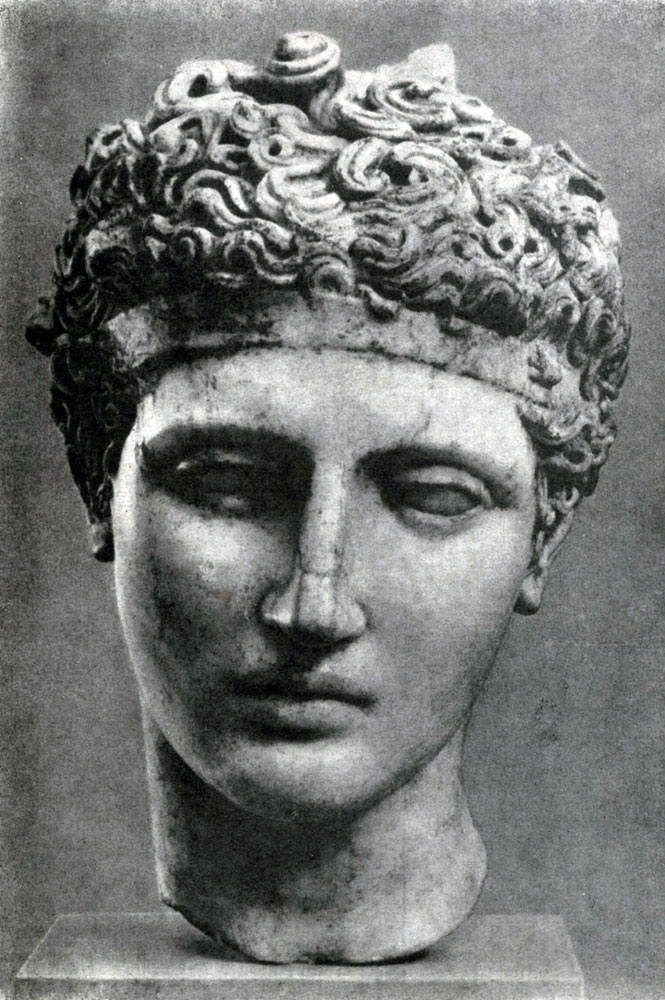
On the other hand, in the same circle of Phidias, works began to appear that sought to enhance the dramatic action, intensifying the themes of struggle, so widely represented in the Parthenon reliefs. Reliefs of this kind, saturated with violent contrasts and intense dynamics, with a rough sharpness of realistic details, were made by sculptors whom Ictinus invited to decorate the temple of Apollo built by him in Bassae (in Phigalia). This frieze, depicting the battle of the Greeks with centaurs and Amazons, was, contrary to the usual rules, set in a semi-dark naos and was executed in high relief with vigorous use of contrasts of light and shadow. For the first time, elements of a more subjective and emotionally acute perception than was usually accepted were introduced into these reliefs (though “far from first-class in quality”). The rendering of the violent and crudely expressive movements of the combatants, given from different angles, reinforced this impression.
Among the masters of the Fidiev school by the end of the 5th century. BC. There also appeared a tendency to express lyrical feelings, a desire to convey grace and elegance of movements with particular softness. At the same time, the image of a person remained typically generalized, without losing its realistic truthfulness, although often losing the heroic strength and monumental severity so characteristic of works created several decades earlier.
The most prominent master of this direction in Attica was Phidias' student Alkamenes. He was a successor to Phidias, but his art is characterized by refined lyricism and a more intimate interpretation of the image. Alkamen also owned some statues of a purely Phidiian character (for example, the colossal statue of Dionysus). However, new quests appeared most clearly in his works of a different order, as, for example, in the famous statue of Aphrodite, which stood in the garden on the banks of the Ilissa River - “Aphrodite in the Gardens.” It has come down to us in copies and replicas from Roman times.
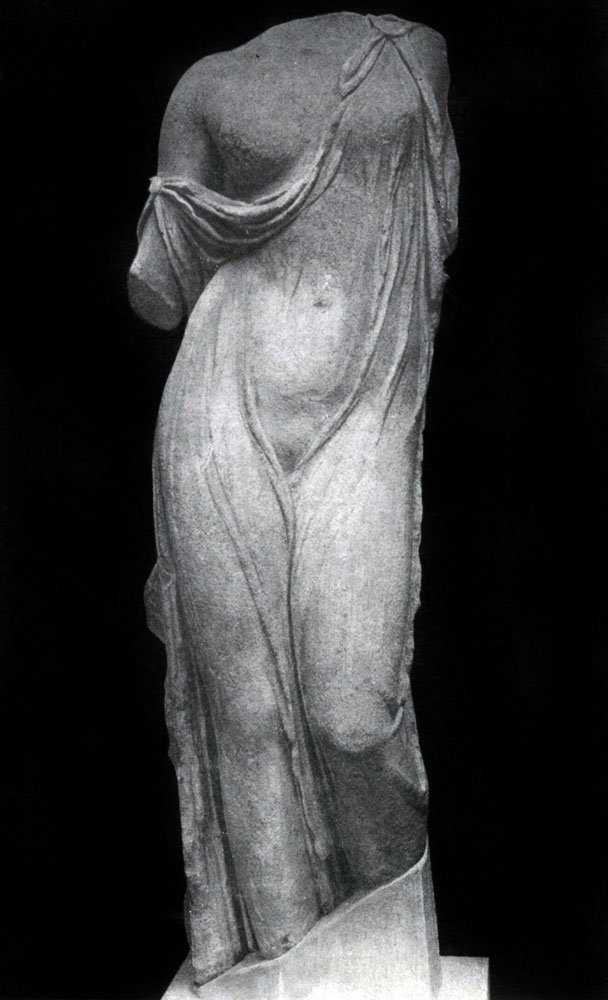
Aphrodite was depicted by Alkamen standing calmly, slightly bowing her head and with a graceful movement of her hand throwing back the veil from her face; in her other hand she held an apple, perhaps a gift from Paris, who recognized Aphrodite as the most beautiful among the goddesses. With great skill, Alkamen conveyed the flowing folds of Aphrodite’s thin long robe, enveloping her slender form. The perfect beauty of man was colored here with an admiring and tender feeling.
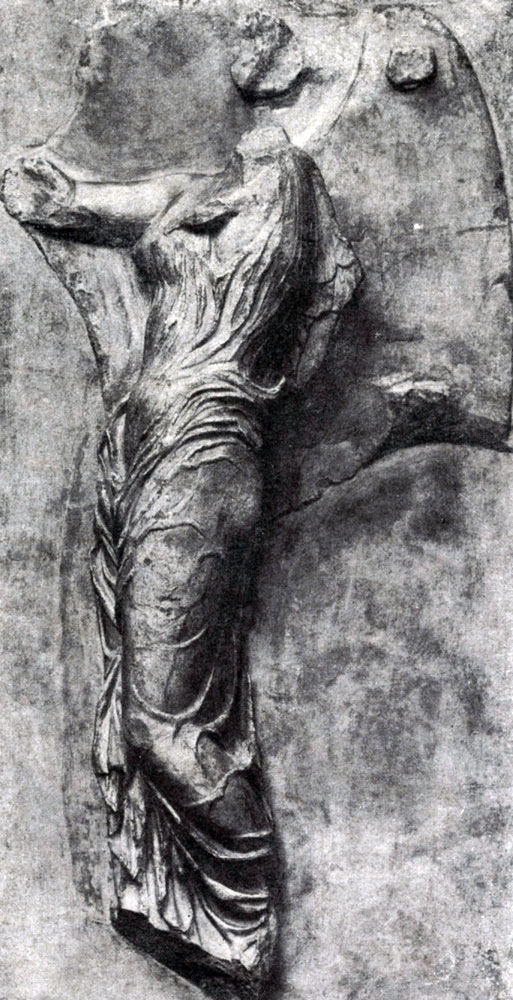
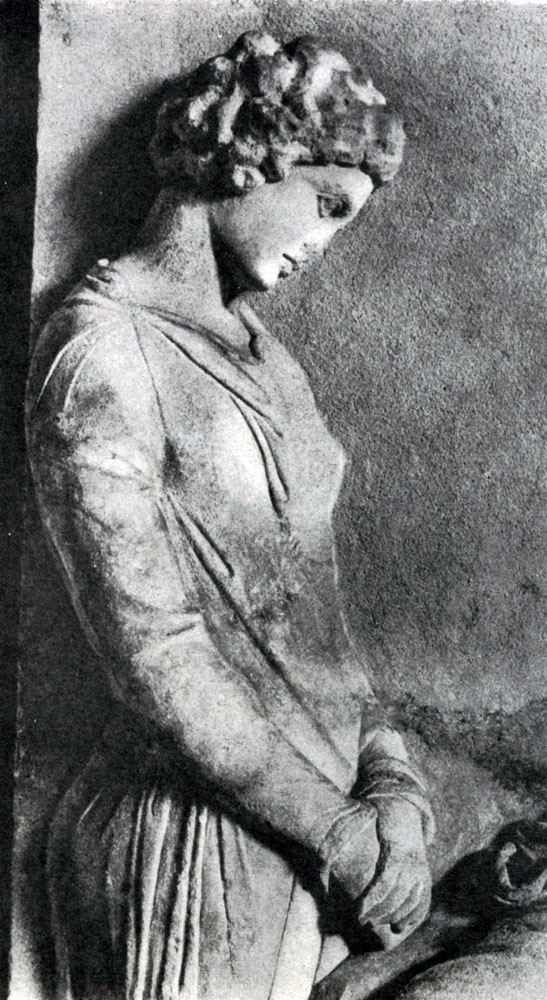
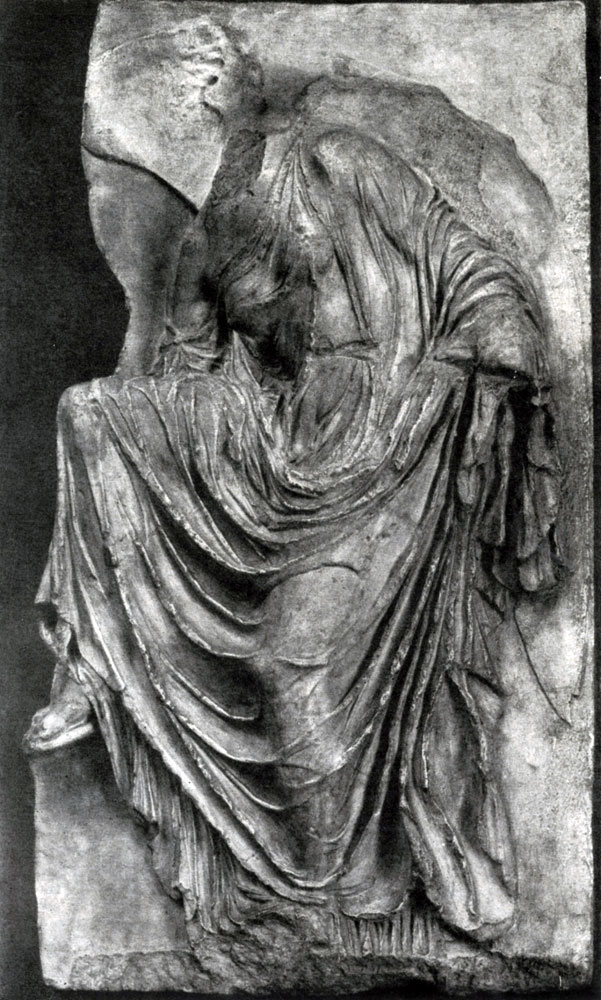
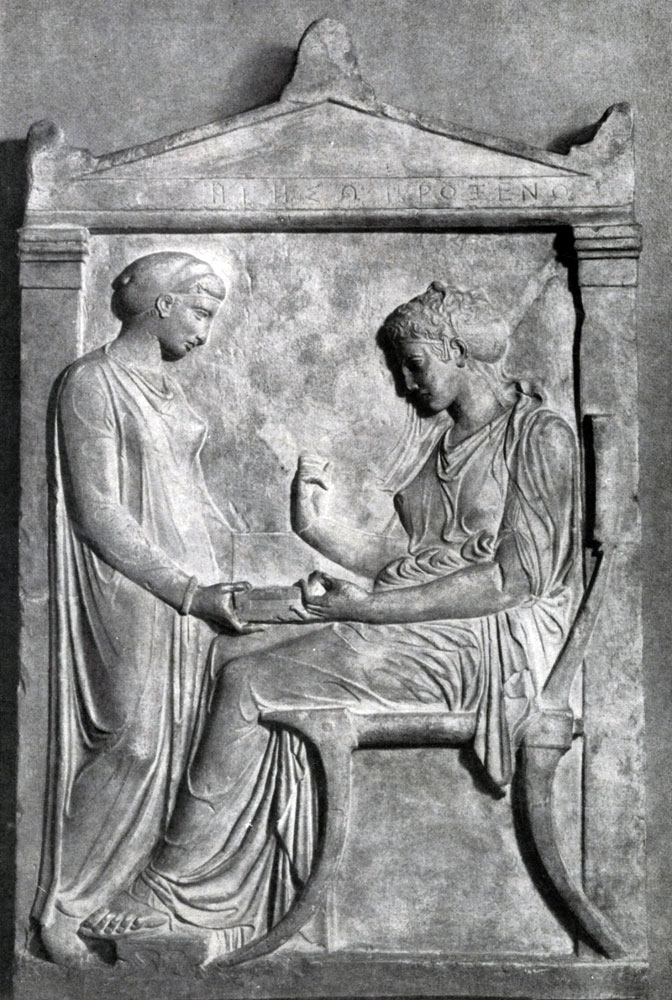
To an even greater extent, such searches for a lyrical image found their fulfillment in those created around 409 BC. marble reliefs of the balustrade of the Temple of Nike Apteros on the Acropolis. These reliefs depicted girls performing a sacrifice. The remarkable relief “Nike Untying her Sandal” is one of the masterpieces of high classical sculpture. The lyricism of this work is born from the perfection of proportions, and from the deep shimmering chiaroscuro, and from the gentle softness of movement, emphasized by the flowing lines of the folds of clothing, an unusually graceful, lively and natural movement. Numerous reliefs on tombstones, excellent examples of which were created at the end of the 5th century, played a very important role in the formation of this lyrical trend in high classics. BC. Such, for example, is “Hegeso’s Tombstone,” which in its purely everyday truth carries a high poetic feeling. Among the many tombstone reliefs that have come down to us from the late 5th - early 4th centuries. The Mnesarete stele and the tombstone in the form of a lekythos from the Leningrad Hermitage also stand out. The ancient Greeks treated death very wisely and calmly: in the tombstones of the classical period one can find neither fear of death nor any mystical sentiments. They depict living people, their theme is farewell, imbued with thoughtful reflection. The tombstones of the classical era, with their bright, elegiac mood, were intended to console and support a person in his suffering.

Changes in artistic consciousness that emerged in the last decades of the 5th century. BC, found their expression in architecture.
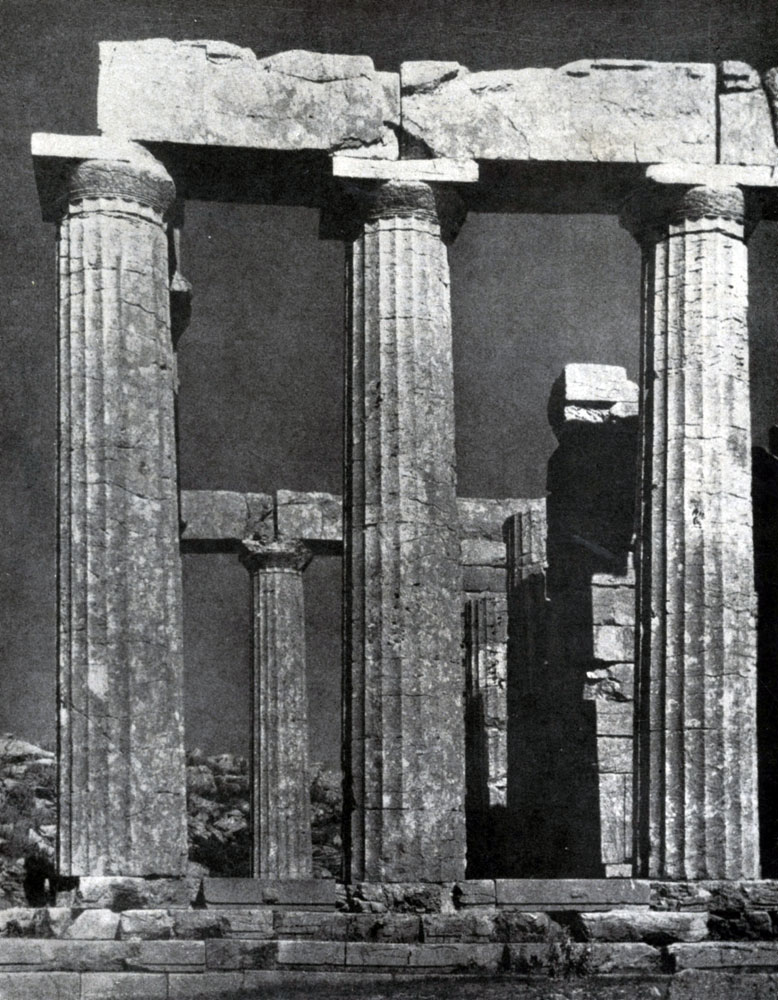
Already Iktin boldly expanded the creative quest for classical architectural thought. In the temple of Apollo in Bassae, he for the first time introduced into the building, along with Doric and Ionic elements, the third order - Corinthian, although only one column inside the temple carried such a capital. In the Telesterion, which was built by Ictinus at Eleusis, he created a structure of an unusual plan, with a vast columned hall.

Equally new was the whimsically asymmetrical construction of the Erechtheion building on Acropolis of Athens, made by an unknown architect in 421 - 406. BC.
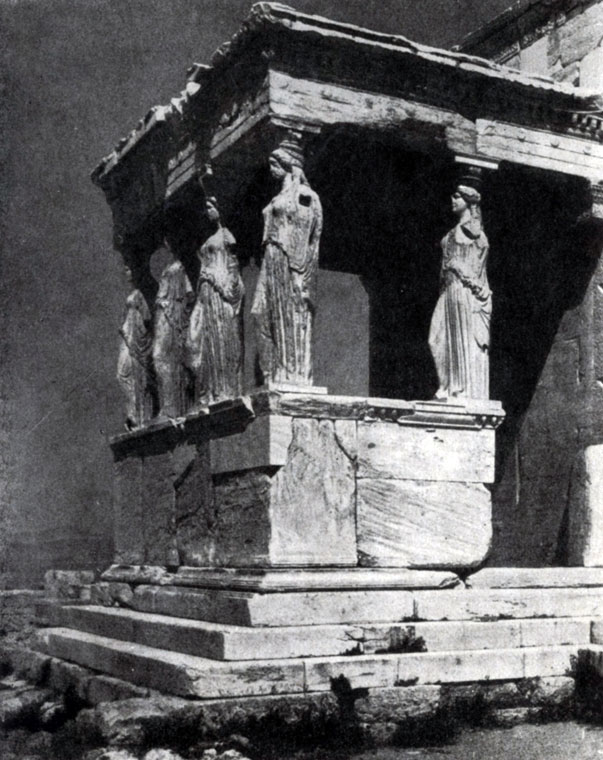
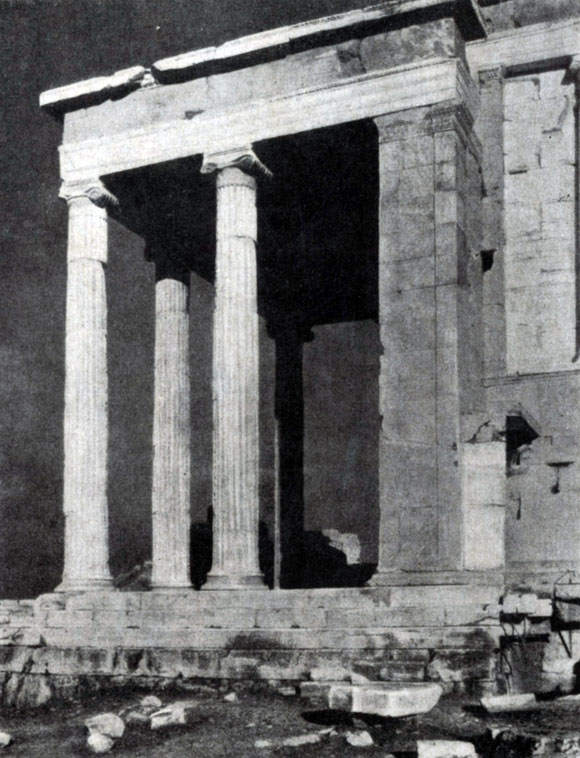
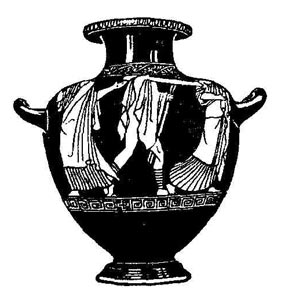
The location of the building in the general ensemble of the Acropolis and its dimensions were completely determined by the nature of the architecture of the heyday of the classics and the plans of Pericles. But the artistic development of this temple, dedicated to Athena and Poseidon, introduced new features into the architecture of classical times: a pictorial interpretation of the architectural whole - an interest in comparisons of contrasting architectural and sculptural forms, a multiplicity of points of view, revealing new, diverse and complex impressions. The Erechtheion is built on the uneven northern slope of the Acropolis, and its layout cleverly took advantage of these uneven ground: the temple consists of two rooms at different levels, it has different porticoes on three sides - including the famous portico of the kor (caryatids) on the south wall - and four columns with gaps covered with gratings (later replaced by stonework) on the fourth wall. The feeling of festive lightness and graceful harmony is caused by the use of a more elegant Ionic order in the exterior design and the beautifully used contrasts of light porticoes and smooth walls.
The Erechtheion did not have external painting; it was replaced by a combination of white marble with a purple frieze band and gilding of individual parts. This unity of color scheme served to a large extent to unify the diverse, although equally elegant, architectural forms.
The bold innovation of the unknown author of the Erechtheion developed a living creative tradition of high classics. However, in this building, beautiful and proportionate, but far from the strict and clear harmony of the Parthenon, the path to the art of the late classics was already being laid - an art more directly human and emotional, but less heroic than the high classics of the 5th century. BC.
Vase painting in the era of high classics developed in close cooperation with monumental painting and sculpture.
Relying on the realistic achievements of the first third of the century, the vase painters of high classics, however, sought to moderate the harshness in the rendering of details of nature or motives of movement, which was encountered earlier. Great clarity and harmony of composition, majestic freedom of movement and, most importantly, great spiritual expressiveness became characteristic features of vase painting of this time. At the same time, vase painting moved somewhat away from the specific genre of subjects that was observed in the first third of the century. More heroic images on mythological themes appeared in it, preserving all the humanity of the early classics, but clearly seeking the monumental significance of the image.
Vase painters of the mid-5th century. BC. began to attract the image of not only the action, but also the mental state of the heroes - the mastery of gesture and the integrity of the composition deepened, although at the expense of some loss of the spontaneity and freshness that distinguished the creations of Duris or Brig. As in the sculpture of high classics, the images of vase painting of this time conveyed the most general states of the human spirit, without attention to the specific and individual feelings of a person, to their contradictions and conflicts, to the change and struggle of moods. All this has not yet entered the sphere of attention of artists. But at the cost of some generalization of feeling, it was achieved that the human images created by vase painters of the mid-5th century. BC, have such typicality and such clear purity of their mental structure.
Monumental severity and clarity are characteristic of the painting of the famous “Crater from Orvieto” - a vase kept in the Louvre with a scene of the death of the Niobids on one side and an image of Hercules, Athena and the Argonauts on the other. The figures are freely and naturally located on the surface of the vase, although in order to preserve the integrity of this surface, the artist avoids perspective reductions, figures that are meaningfully placed in the background. Masterful use of angles, lively, natural poses of the figures are subordinated to a strict, calm rhythm, uniting the image with the equally harmonious shape of the vase. In the “Crater from Orvieto” the red-figure vase painting reaches one of its peaks.
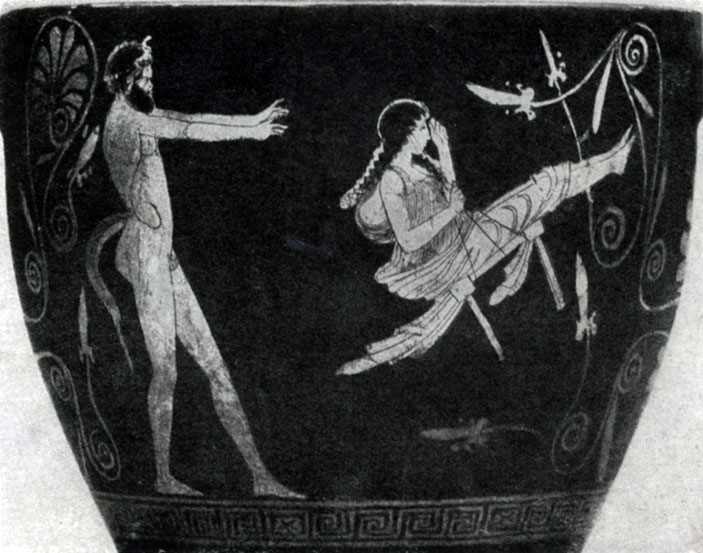
Examples of high classic vase paintings include such drawings made in the second half of the century as “A Satyr swinging a girl on a swing during a spring festival”, “Polyneices holding out a necklace to Eriphyle” (the so-called “Vase from Lecce”) and many others.
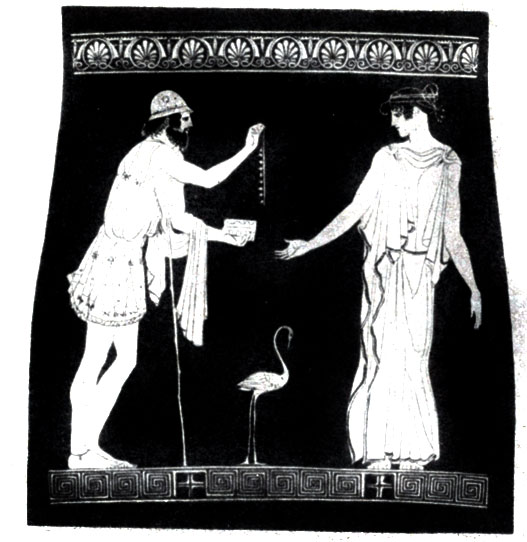
Around the middle of the century, lekythos painted on a white background became widespread, serving for cult purposes (related to the burial of the dead). In them, the drawing often achieved a particularly relaxed lightness (sometimes turning into carelessness); it was applied with black varnish, outlining the main lines of the figure, and after firing it was painted (which is why sometimes the figures look naked because of the faded paint). An example of a masterful design on a white background is the image of a girl bringing gifts to the deceased on the Attic lekythos of the Boston Museum.
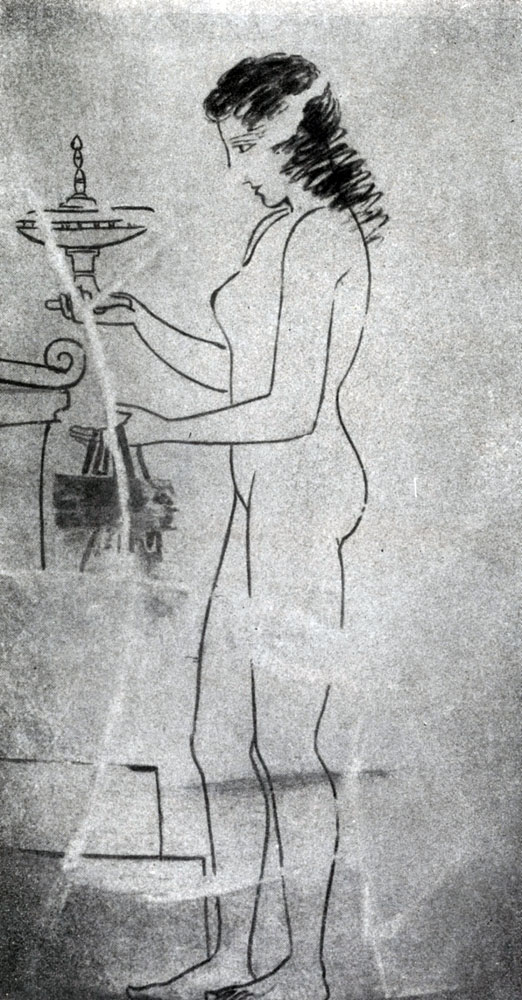
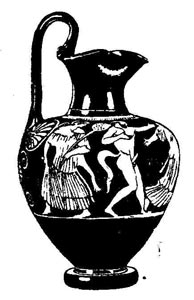
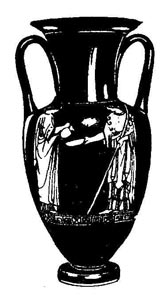
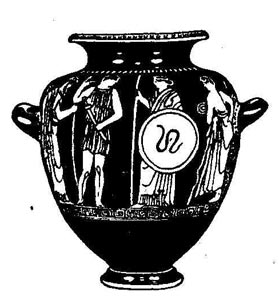
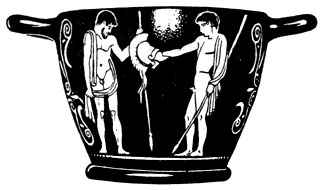
By the end of the 5th century. BC. Vase painting began to decline. Already Midius and his imitators began to overload the designs on vases with decorative details; in this elegant patterned ornamentation, the figures of people, depicted in intricate foreshortening formations, lost their primacy - they became impersonal and identical, getting lost among the fluttering draperies. Crisis of free labor at the end of the 5th century. had a particularly detrimental effect on the creativity of ceramicists and draftsmen. Vase painting began to lose its artistic quality, gradually turning into a mechanical and faceless craft.
The painting of the classical period that has not reached us, as far as one can judge from the statements of ancient authors, had, like sculpture, a monumental character and was inextricably linked with architecture. It was, apparently, most often executed in fresco; it is possible that in the 5th century. BC, at least in the second half of it, adhesive paints were used, as well as wax paints (the so-called encaustic). Adhesive paints could be used both directly on a specially prepared wall, and on primed boards that were fixed directly on the walls intended for painting.
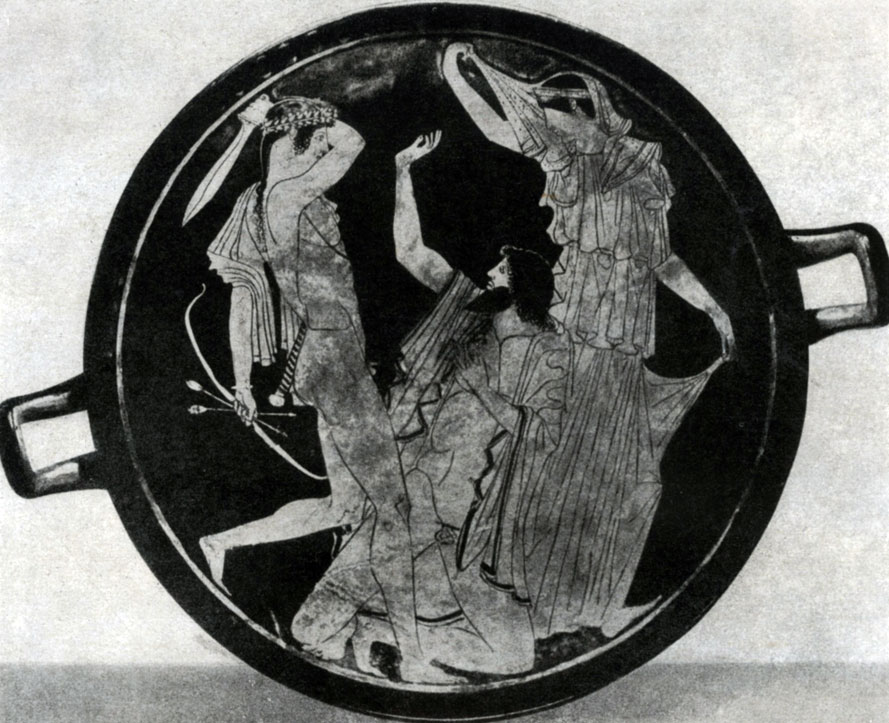
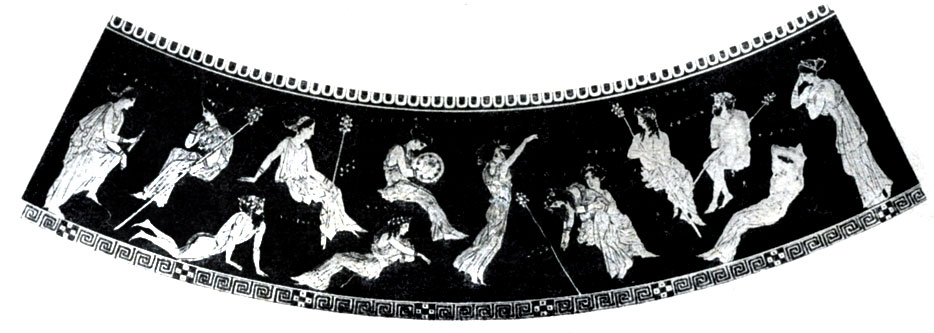
Painting in the 5th century. BC. had a strictly generalized monumental character and was created for a specific place in architectural ensemble. No reliable information about the existence of easel works has survived. Just as monumental sculpture was complemented by small sculptures made of terracotta or bronze, closely connected with artistic crafts and applied arts, so monumental painting, bypassing its actual easel forms, was supplemented by vase painting, inextricably linked with the art of ceramics. Monumental painting occupied an important place in the artistic life of that time. The best works enjoyed great fame. The greatest masters of painting were widely known and surrounded by public honor along with outstanding sculptors, poets, playwrights of their time.
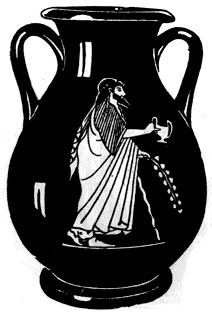
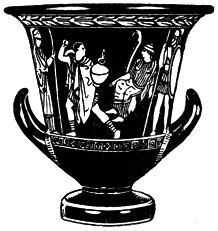
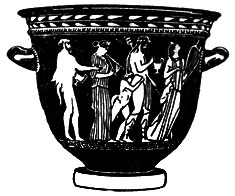
Painting 5th century BC. in its aesthetic principles it was very close to sculpture, being in close relationship with it. The essentially pictorial objectives of painting were mainly reduced to the illusory reproduction of the volume of the human body. The task of depicting the environment surrounding a person and his interaction with it in 5th century painting. was not installed. The actual pictorial means of depiction - chiaroscuro, color, conveying atmosphere, spatial environment - were just emerging, and then mainly at the end of the 5th century. BC. But the main goal at the end of the century remained the desire to find artistic means that convey plastic volume.
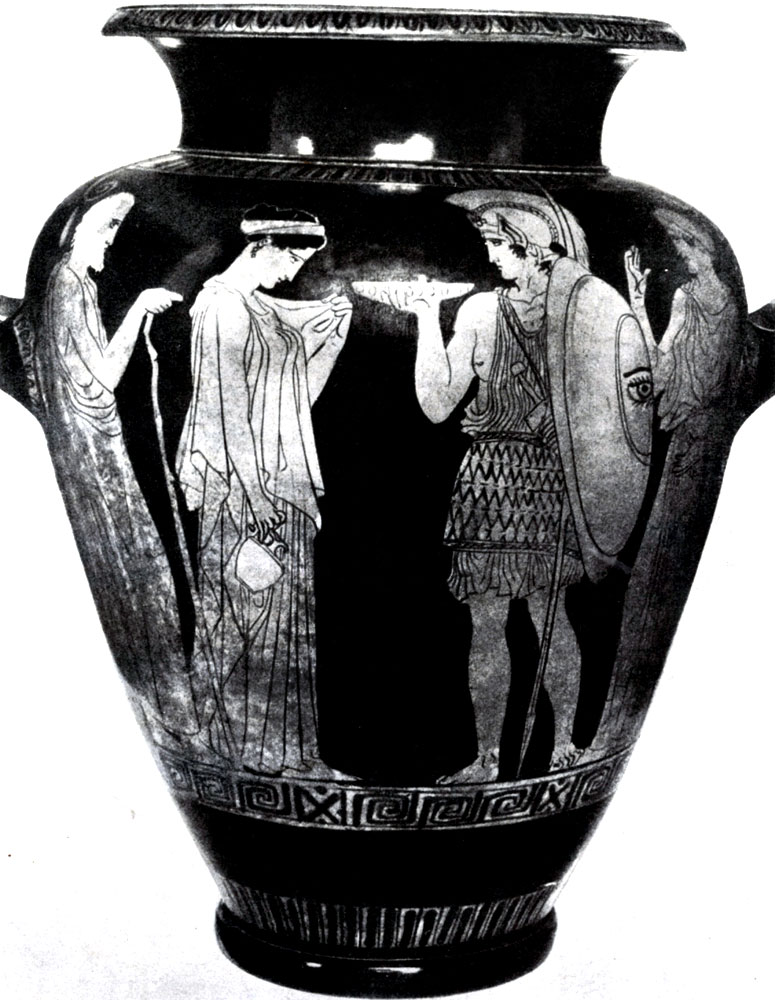
Only later, already in the period of the late classics, in connection with the general change in the nature of artistic ideas, these achievements began to be used consciously to depict a person in his natural and everyday environment, for a richer pictorial and emotional characterization of him.
Thus, 5th century. BC. - This is the time of laying down the prerequisites for revealing the visual possibilities of painting. At the same time, the realistic depiction of a person or group of people in various actions, the use of correct anatomical proportions, the truthful rendering of the physicality and volume of human forms, the emergence of a consistently realistic understanding of the plot meant a big progressive step in the history of painting compared to earlier conventional or purely decorative compositions.
The largest master of the second quarter and mid-5th century. BC) a contemporary of Myron, was Polygnotus, a native of the island of Thasos, who received the honorary title of Athenian citizen for his work performed for Athens.
Polygnotus's range of themes was close to those addressed by the masters of pediment compositions and reliefs. These were epic themes (from the Iliad, poems of the Theban cycle) and mythological (the battle of the Greeks with the Amazons, the battle with the centaurs, etc.). An important feature of Polygnotus’s writing was the appeal to themes of a historical nature. Thus, in the Pinakothek in Athens, the painting of which was supervised by Polygnotus, among other frescoes, an image of the “Battle of Marathon” was made.


In all likelihood, however, these paintings on historical themes had the same generalized heroic character as the compositions glorifying the high deeds of mythical heroes. Just as Aeschylus's "Persians", dedicated to the naval victory of the Hellenes over the hordes of Xerxes, are built on the same artistic principles as his "Oresteia" or "Seven against Thebes", so these historical compositions of Polygnotus were apparently decided on the same plan , as mythological paintings, and were included with them in the same general ensemble.
One of the most famous works of Polygnotus was the painting of the “Leschi (meeting house) of the Cnidians” in Delphi, a description of which was preserved by Pausanias, where Polygnotus depicted “The Death of Troy” and “Odysseus in Hades”.
It is known that Polygnotus used only four colors (white, yellow, red and black); Apparently, his palette did not differ too sharply from that used by the masters of vase painting. According to the descriptions, Polygnotus’s color was in the nature of coloring and he almost did not use color modeling of the figure. But his drawing was highly perfect. He accurately conveyed the anatomically correct body in any angles and movements. The ancients admired the fact that Polygnotus achieved perfection in depicting the face, that he for the first time began to convey a state of mind, in particular, with the help of a slightly open mouth, trying to give the face features of emotional expressiveness. Similar experiments in sculpture were carried out by the masters of the western Olympic pediment just during the heyday of Polygnotus’s activity.
Descriptions of Polygnotus's paintings give reason to believe that the master did not set himself the task of giving a holistic image of the environment in which the action takes place. Ancient authors mention individual objects of nature and furnishings, plot-related to the actions of the heroes, for example, pebbles on the seashore, but not depicted in the entire picture, but only to determine the location of the hero. “The seashore continues up to the horse, and pebbles are visible on it, then there is no sea in the picture,” says Pausanias, describing Polygnotus’s painting “The Death of Troy.” Apparently, Polygnotus and other painters of the 5th century. BC. they were not yet fully aware of all the possibilities of painting and did not feel the fundamental difference between the depiction of pebbles of the seashore on a relief (as in the scene of the birth of Aphrodite on the “Throne of Ludovisi”) and the task of depicting the seashore in a painting. Ancient authors have no information about Polygnotus’ solution to problems of perspective or light and shade. The composition, apparently, was more or less frieze-like in nature.
Polygnotus's contemporaries highly valued his painting for the same qualities that they valued in sculpture: greatness of spirit, high moral strength (ethos) of the heroes, truthfulness in the depiction of a beautiful person.
Polygnotus did a lot for the realistic, clear and concrete depiction of man in painting. The subsequent development of Greek art, the constant growth of interest in the inner world of man, in the direct sensory perception of his image, the emergence of greater interest in everyday life and the environment gradually expanded the range of visual tasks facing painting.
In the second half and at the end of the 5th century. BC. A number of painters appeared, closely associated with the general trends in the development of the Attic sculptural school of the late 5th century. BC. The most famous master of this time was Apollodorus of Athens. His painting, which treated traditional subjects in a more intimate and genre-based manner than his predecessors, was characterized by greater freedom of color and an interest in modeling body shapes through chiaroscuro. Pliny says of Apollodorus that “he was the first to begin to transmit shadows.” Of great importance are the instructions of ancient authors, which give reason to assume that Apollodorus and other painters of the late 5th century. BC. (Zeuxis, Parrhasius) began to develop not only problems of depicting the human body in motion, but also perspective, both linear and aerial. The constant goal of these painters was to create realistic, beautiful and living human images.
Beginning with Apollodorus, Greek painting ceased to be a reproduction of sculptural figures on the plane of a wall, but became painting in the proper sense of the word. Apollodorus was one of the first painters to move on to painting paintings that were not organically connected with an architectural structure. In this regard, he not only further developed the high traditions of the 5th century classics. BC, but also outlined new paths of realistic art, leading to the late classics.
